If you are planning a trip to Japan, then a visit to the ancient city of Kyoto should be on your list, not just because of the 1,600 buddhist temples, but because it is overflowing with culture, tranquil gardens and colourful shrines. There is no way that you will be able to see all the beauty that Kyoto has to offer in one visit alone, but this packed Kyoto 2 day itinerary is a good introduction to travellers who do not have too much time here, yet still want to experience as much as possible.
Planning a trip to Japan can be somewhat overwhelming – most of us have a limited amount of time for our travels and want to see as much as we possibly can of the country we are visiting. I want to offer some consolation and say that it would involve months, if not years, to explore all the secrets that Kyoto (and all other cities in Japan) to offer.
This article was not written to be the ‘ultimate guide’ to Kyoto for that reason. What it will be, however, is a useful resource for your first trip to Japan. This itinerary will slot 2 days in Kyoto into your Japan holiday schedule and ensure you make the most of your time in this fascinating city. It covers everything from the best time to visit, how to get to Kyoto, a variety of places to stay, the best Kyoto restaurants, the best things to see and the most worthwhile Kyoto experiences. Let’s kick off!
This article contains affiliate links
The Best Time to Visit Kyoto
This article is being published in early March and it has now been two weeks since our return from Japan. Overall the weather was pleasant and mostly mild, however we did have the odd rainy day here and there, both in Tokyo and Kyoto. It is worth noting that some experiences are better reserved for a day when it is not raining but I’ll highlight this on the specific experiences themselves further down in this article.
A word to those who are not keen on holidays at peak times of tourism. You’re probably well aware that the peak of Japan’s tourism occurs during cherry blossom or Sakura season. It is during this period that you will be able to see the trees blossoming in beautiful shades of pink and naturally, thousands of tourists flock to cities like Kyoto to view this phenomenon. If this is you, I would recommend visiting around the time we did – the end of February. Whilst it was still a little cold, there were far fewer tourists and we were able to view the plum blossoms!
The table below highlights the peak and off-peak seasons throughout the year, what you can expect in terms of weather, as well as the level of tourism.
| Month Range | Season | Weather Notes | Events | Tourism |
|---|---|---|---|---|
| March/April/May | Spring | Mild, with temperatures beginning to warm up from mid-March. Evenings remain cool. Best time to visit for cherry blossom. |
Plum blossom (ume) and cherry blossom (sakura) season Golden Week (5-day weekend) in May |
High |
| June/July/August | Summer | Hot and humid Mid-June – July: rainy season |
17 July: Gion Matsuri, the biggest festival of the year | Low |
| September/October/November | Autumn | Moves from mild to cold as winter approaches | Mid-October: Beginning of autumn/fall foliage season | High |
| December/January/February | Winter | Generally cold January: snow |
Late February: Beginning of plum blossom season | Low |
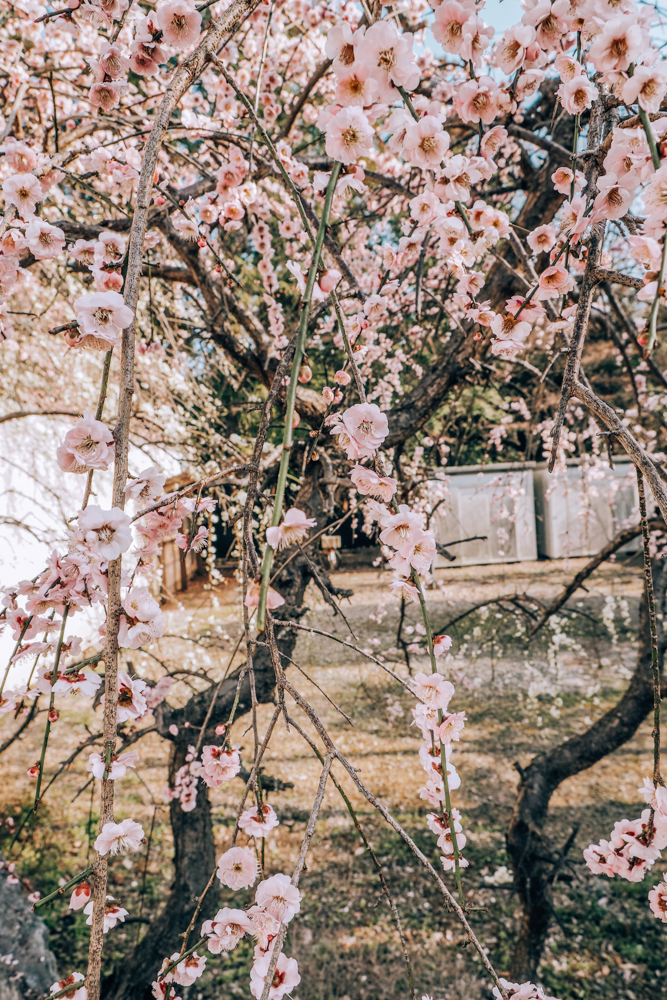
Travel Insurance If Travelling to Japan
Before diving into this Kyoto 2 day itinerary, it’s important that I give a quick reminder on travel insurance. Make sure that you are covered in case anything happens to you whilst travelling, especially in a country that is far away from home.share
Getting to Kyoto
By Plane
If you plan on travelling to Kyoto via plane, commercial or private, the best option is to fly into one of Osaka‘s two airports – either Kansai International Airport (KIX) and Osaka International Airport, better known as Itami (ITM). Don’t be fooled by the name, Osaka International is Osaka’s domestic airport and only handles national flights, so unless you are flying into Osaka from another part of Japan, this won’t be relevant for you.
Osaka International Airport (or Itami) – ITM
If you are, however, taking an internal flight and plan on landing at Itami, you can easily get to Kyoto via the Osaka Airport Limousine bus, which costs 1,340 yen and takes around 50 to 55 minutes. You can find the schedule in the link above, however no reservations are necessary. It operates on a first come, first serve basis.
Tickets can be purchased from the ticket machines just outside the arrivals hall. Once you’ve got your ticket in hand, head outside and wait curbside at the correct boarding point. The stopping point in Kyoto is just near Avanti department store, right by the Kyoto train station. The department store also sells tickets for your return back to the airport if needed – just ask one of the shop attendants! This article is useful for those taking the airport bus for the first time.
If you are looking for transport that will drop you off and pick you up directly from your hotel, there is also the option of the Shared Taxi Van. As the name suggests, the van will be shared by up to 9 people per shuttle. It can therefore be a little more time consuming as the van will stop at the hotels of each of the passengers. A return journey from Itami Airport is around 5,800 yen at the time of publishing. It is advisable to book your tickets at least 2 days in advance.
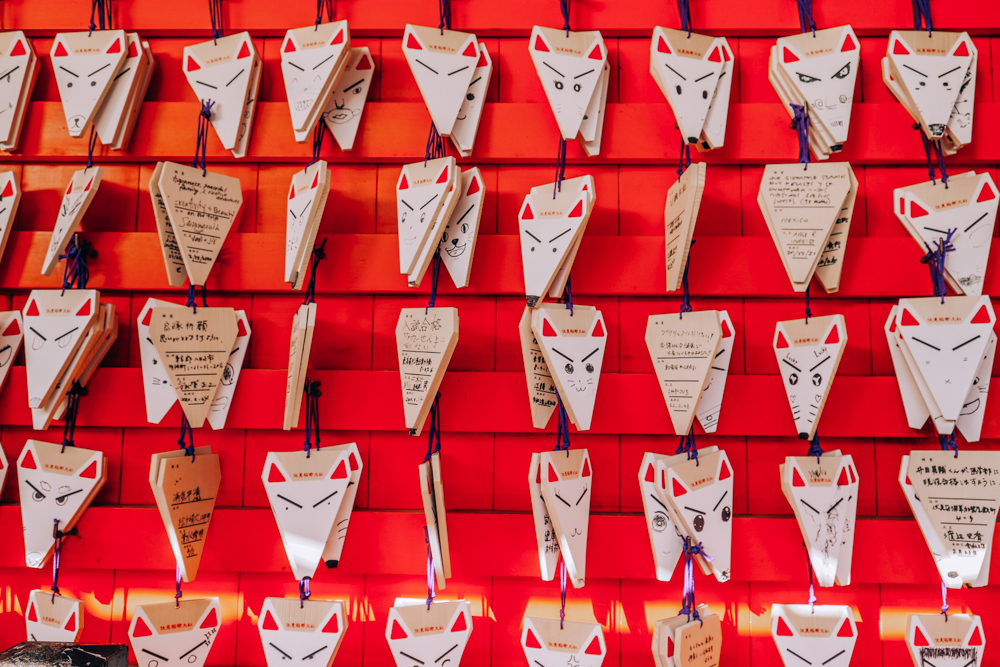
Kansai International Airport – KIX
An easy and convenient way of getting from Kansai to Kyoto is using the Japan Rail Pass on the Limited Express Haruka. The Limited Express Haruka runs about 30 round trips between Kyoto Station and Kansai Airport Station every day from platform 4. Luggage space is available on the train and there is no need to reserve seats.
If you need train tickets and have just landed in Osaka, it may all be overwhelming. My advice would be to make a first stop at Travel Desk of Kansai Tourist Information Center and enquire about tickets for the Limited Express Haruka. The normal fare for the journey between Kyoto Station and Kansai Airport Station is 2,850 yen.
We actually decided to purchase our 7-day Japan Rail Pass ahead of time and exchange vouchers were sent to us in London via DHL. These then need to be taken to a JR ticket office to be exchanged for the the actual tickets. We found a great offer where we were given a free Japanese SIM card with unlimited 4G for each JR Pass that we purchased. It’s worth noting that this was incredibly useful as we constantly relied on Google translate to help us get where we needed to be. I would highly recommend having a look at the Klook website to search through all their offers, as you never know what you’ll find!
Additionally, you can also take the same Limousine Bus as mentioned above to travel from Kansai to Kyoto. At the time of publishing in March 2020, it costs 2,600 yen and takes around 90 minutes. Whilst no reservations are strictly necessary, and it operates on a first come, first serve basis, you can actually purchase a limousine bus ticket online with Klook.com, and your mobile voucher for a physical ticket at the airport.
Last but not least, the Shared Taxi Van is also available from Kansai Airport for a round trip cost of 8,400 yen. The exact same conditions apply as above. If all of this is overwhelming – which I can definitely appreciate – I’ve summarised it all in a neat little table below.
| AIRPORT | TRAVEL OPTION | NOTES | |
|---|---|---|---|
| Itami Airport – ITM | Bus | Airport Limousine | – First come, first serve – Airport to Kyoto Station |
| Shared Taxi Van | – Requires 2-days notice for tickets – Airport to hotel – Shared with up to 9 passengers |
||
| Car | Rental Car | – Valid international driver’s license needed | |
| Private Taxi | – Most expensive option – Do not hail cab from the street |
||
| Kansai Airport – KIX | Bus | Airport Limousine | – First come, first serve – Tickets also available – Airport to Kyoto Station |
| Shared Taxi Van | – Requires 2-days notice for tickets – Airport to hotel – Shared with up to 9 passengers |
||
| Train | Limited Express Haruka | – Can use a JR Pass | |
| Car | Rental Car | – Valid international driver’s license needed | |
| Private Taxi | – Most expensive option – Do not hail cab from the street |

By Train
From Tokyo
This was how we got to Kyoto – by taking the ‘bullet train’ or high-speed Hikari Shinkansen direct from Tokyo Station to Kyoto Station. It was easy and efficient, with the ride taking a grand total of 2 hours and 40 minutes (even though we were on the Hikari – more on that below). Seats are reserved in certain carriages and there is ample space for luggage, both in the luggage racks and overhead. The good news is that you can take the ‘bullet train’ (which is an experience in itself) for no additional cost if you have already purchased your JR Pass. Once purchased, the exchange vouchers will be sent over to you via DHL.
Once you have the exchange vouchers in your possession, it is then necessary to exchange these for rail passes at a JR ticket office at Tokyo Station. Tip for travellers: if using electronic devices is something you plan to do on the train, you probably want a window seat so that you have access to a socket and can charge your phone/laptop/tablet… since the seating is reserved in some carriages, these are the seats that tend to be reserved first. If you can, I would suggest stopping by a JR ticket office a few hours in advance of your train so that you can reserve a window seat.
It’s worth noting that there are three different Shinkansen trains and again I have summarised these below for your convenience (and so that you can make sure you get the right train!).
| Tokaido Shinkansen ‘Bullet’ Train | Covered by JR Pass? | Time Taken from Tokyo to Kyoto | Frequency | Stops |
|---|---|---|---|---|
| Hikari | Yes | – Second fastest bullet train – About 3 hours from Tokyo to Shin-Osaka |
Every 30 minutes | – Major cities Tokyo, Yokohama, Nagoya, Kyoto, and Osaka as well as a few other stops (these vary by train) |
| Kodama | Yes | – Slowest of the three Tokaido shinkansen – Around 4 hours |
– Stops at every stop on the line, including a few famous hot springs | |
| Nozomi | No | – Fastest bullet train – Around 2 hours 40 minutes |
– Makes the least amount of stops, only stopping in Tokyo, Shinagawa, Shin-Yokohama, Nagoya, Kyoto, and Shin-Osaka |
From Osaka
The fastest way to get from Osaka to Kyoto is by train. Once again, travellers can take the high speed Shinkansen train from Shin-Osaka Station to Kyoto Station and takes a mere 13 minutes. Once again, you can use that same JR Pass for this.
Where to Stay in Kyoto
According to the Japan National Tourism Organization, Kyoto is the most popular tourist destination in Japan and there is good reason for it. It’s a city that sums up everything you would expect from Japanese culture including ancient temples, traditional ryokans, geishas and tea ceremonies. For this reason, it is advisable to book your accommodation well in advance. Japan is already quite an expensive destination when it comes to lodging, and this is only exaggerated during peak tourism times such as cherry blossom season or Golden Week.
The question on many people’s mind is where is the best place to stay in Kyoto. My reply to this is it really depends on what you want to see – there is no right or wrong answer as there is so much to see in Kyoto and chances are you won’t see it all. It also depends on your budget. If prices of the kind of hotels you are interested in are now more than you would like to spend, it may even make sense to stay at a hotel in nearby Osaka since the two cities are only around 50 kms apart.
It’s also worth highlighting that the transport system in Kyoto is not as well connected as nearby Osaka, and staying close to a station is highly recommended. For first-timers who have just 2 days in Kyoto, I would suggest staying in downtown Kyoto – in Higashiyama Ward and within walking distance of Gion District. Each of the suggested hotels below are located here. I have also included a Booking.com search box in case you would prefer to look for your own.
Best Luxury Hotels in Kyoto
Three of the top large luxury hotel chains that can be found in Kyoto, all in the Higashiyama district.
Four Seasons Kyoto
The epitome of luxury. The Four Seasons Kyoto is an intimate hideaway in Kyoto’s temple district. Surrounded by natural beauty, this 800 year-old Shakusuien or ‘pond garden’ offers guests the finest in Japanese tradition, hospitality and above all, tranquility.
The Ritz Carlton Kyoto
Yet another example of Kyoto’s finest – the Ritz Carlton Kyoto, situated on the banks of the Kamo River in the trendy Gion District, this luxurious retreat is just walking distance away from the region’s finest shopping and entertainment.
Park Hyatt Kyoto
Set in the heart of Higashiyama is the Park Hyatt Kyoto – a hillside retreat and architectural gem that blends in seamlessly with the natural surroundings and ancient temples.
Best Luxury Ryokan in Kyoto
Ryokans are traditional Japanese guest houses, similar to a Western-style inn. Ryokans are not known for their opulence and luxury, but rather for their traditional Japanese hospitality and service. Japanese Guest Houses wrote a great article with further information on what you can expect to find inside a ryokan guest room. Here are some of the nicest I have come across.
Kyoto Ryokan SAKANOUE
Conveniently located next to Gion’s historical hotspots, Kyoto Ryokan Sakanoue offers Japanese-style accommodation and Kyoto-style meals, all in this much-loved part of Kyoto.
Yuzuya Ryokan
This quaint little ryokan in the famous Gion of Kyoto is located just a few steps away from the Yasaka Shrine. The guest rooms here feature antique furnishings, seasonal wildflower arrangements and modern-style bathrooms.
Seikoro Ryokan
Established in 1831, Seikoro Ryokan offers the very best of Kyoto traditions, charming Japanese hospitality and delicious cuisine.
Sowaka Ryokan
The newly opened Sowaka Ryokan offers a truly luxury ryokan with modern comforts, combined with award-winning cuisine at La Bombance Gion.
Best Boutique Hotels in Kyoto
If luxurious opulence yet traditional Japanese ryokans are not what you are after, here are some of the best boutique hotels in Kyoto, for a fine balance between the two.
22 Pieces, Kyoto
Excellently located is 22 Pieces in downtown Kyoto, just a short walk away from many of the city’s well-known temples like Tofuku-ji and Kiyomizu-dera. Each room includes a terrace with a view of a garden or the city.
Hotel Nest at Nishiki, Kyoto
Well-located Hotel Nest at Nishiki offers guests that enjoy city walks, ambience and food a comfortable pied-à-terre moments away from several temples.
Imu Hotel Kyoto
Trendy and recently opened Imu Hotel Kyoto is situated just by Hankyu Karasuma Station and offers chic modern rooms with a shared lounge and cafe bar. A vegan breakfast is also available!
Transport in Kyoto
JR Pass
The JR Pass has been mentioned throughout this article and comes highly recommended. Whilst this has limited travel around Kyoto itself, you may want to use this for day trips to places like Nara, Osaka and Hiroshima. The Kansai-Hiroshima Area Pass might be worth exploring if this is your intention.
Travelers should be aware it is more expensive to buy a JR Pass in Japan than to purchase the pass online. The JR Pass will be available to buy in Japan until March 31, 2021.
Subway & Bus One-Day Pass
In addition to picking up your preferred JR Pass, and given this article assumes you’ll be spending 2 days in Kyoto, I would recommend also purchasing a 2-Day Subway & Bus Pass for 1,700 yen (at the time of publication).
Check out the previous link to read more about the terms and conditions but it is worth noting that you do not have to use this on the day of purchase – which encourages you to purchase your ticket in advance. The pass gets activated the first time you put it through the ticket gate and is usable on the day of activation and the following day. Tickets can also be bought from ticket windows in subway stations.
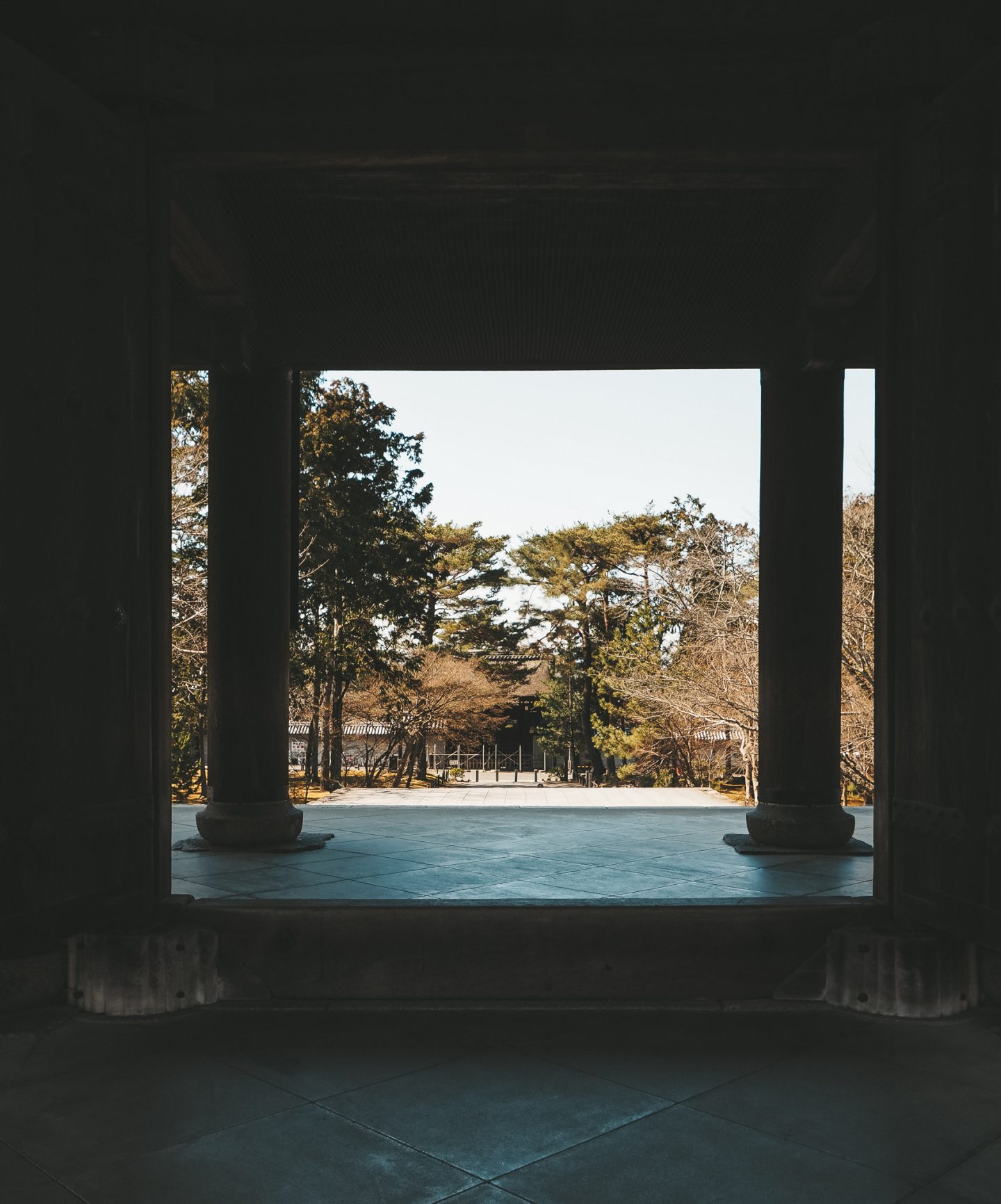
A Kyoto 2 Day Itinerary
If you started this article at the very beginning, you should now have an idea about the best time to visit this ancient city, picked up your travel insurance, know how you are getting to Kyoto and the transport tickets you need when you are there. You should also have some hotels shortlisted for your stay, if not already booked. Now that that is all taken care of, it’s time to dive into the actual Kyoto 2 Day Itinerary.
Prepare yourself for a packed 2 days in Kyoto that will make the most of your time in this incredible city. The days will start at 9am and end in the early evening so admittedly you’ll feel a little exhausted by the end of it – but it’s all totally worth it! This itinerary also assumes that you arrived in Kyoto the evening before. It also assumes that you will have breakfast before heading out on your journey.
Kyoto Itinerary: Day I – Eastern Kyoto
| Time | Experience | Notes |
| 9am | Tea Ceremony and Kimono Experience Kyoto | Central Kyoto Walking distance from the Gion-Shijo Station |
| 11am | Catch a bus from Shijokawaramachi Bus Stop to Ginkakuji mae | Use bus pass described above Use the free 4G SIM card you got with your JP Pass (see links above) and use Google Maps to navigate |
| 11:45am | Ginkakuji Temple | A former retirement villa turned Zen temple built in 1482 |
| 12:30pm | Philosopher’s Path | A 1.5km walk along a beautiful canal, located just outside of Ginkakuji Temple. This 60 minute walk is particularly busy during cherry blossom season |
| 1:30pm | Lunch | Kyoto is known for its tofu and yuba (tofu skin) cuisine and the Philosopher’s Path is a perfect place to sample some of that. Continue walking to Nanzenji Temple (the opposite end of the Philosopher’s Path) |
| 2:30pm | Nanzenji Temple | An important zen temple with a beautiful stone garden, walk 10 minutes to Keage Incline |
| 3:30pm | Keage Incline | One of the most beautiful locations to view cherry blossoms – although admittedly this can be skipped if travelling to Kyoto outside of the sakura season or Golden Week |
| 4:00pm | Heian Shrine | A gorgeous colourful shrine |
| 4:45pm | Time for a sakura latte break! | After all that walking treat yourself to a sakura latte at nearby Starbucks Coffee Kyoto Okazaki Tsutaya Bookstore |
| 5pm | Walk to Higashiyama Streets | You can also take a bus, which will take 15 minutes as opposed to the 30 minute walk, but the walk is very much recommended as you’ll get the opportunity to walk through Maruyama Park (home to the Yasaka Shrine), and if you’re up for it, walk passed the Kodaiji Temple, another tranquil temple and gardens. There is also the option to cycle! |
| 6pm | Higashiyama Streets | Assuming that you stopped to take take a look at the Yasaka Shrine, you should arrive at the Park Hyatt Kyoto at the beginning of the Higashiyama streets. Explore the streets of Higashiyama! |
| 7:30pm | Gion Night Walk | OPTIONAL EXTRA for those that are not yet exhausted, walk over to Gion. Immerse yourself in Kyoto nightlife, eat at a local izakaya and lookout for a real-life geisha! |
Tea Ceremony and Kimono Experience Kyoto
One of my favourite Kyoto experiences was attending a Japanese tea ceremony and learning all about this magic ritual. I recommend beginning your day with a traditional Japanese tea ceremony to get you into that feeling of zen, whilst getting the opportunity to try on a traditional Japanese kimono. The whole experience is truly an art and deserves a whole article to itself – you may want to check it out! It talks all about Japanese tea ceremony etiquette and the lessons it teaches us in every day life.
The whole experience takes approximately 90 minutes. We booked our tea ceremony with Maikoya, a few minutes walk away from Gion-Shijo Station.
Ginkakuji Temple
Once the tea ceremony experience was over, we ventured off to our next destination: the Ginkakuji Temple. There are over 1,600 temples across Kyoto and seeing them all over the course of a few days is pretty much impossible. For this itinerary, we tried to pick out a few options that we thought were worth seeing the most, as well as which made the most sense logistically.
Day I of our Kyoto 2 day itinerary is focused around Eastern Kyoto and Higashiyama, and Ginkakuji is a good starting point. From the location of the tea ceremony, we caught a bus from Naramonocho main street that took us straight to the area where the temple is located. I am reluctant to add bus details as I am aware that these change over time – instead I would encourage anyone visiting Japan for the first time to pick up the JR Pass that is offering a free 4G SIM with unlimited data so that you are able to use Google maps to plot the most accurate route during your time there.
Ginkakuji is a made up of the Silver Pavilion, 6 other temple buildings, a moss garden and a dry sand garden. The interior of the Silver Pavilion is not open to the public – nor is it actually silver. One story explains that the moonlight reflecting on the building’s dark exterior (which was previously covered in black lacquer) gave it a silvery appearance. Others claim that it was named after its construction to contrast it with the Golden Pavilion. Whatever the reason may be, Ginkakuji is the perfect introduction to the world of Kyoto culture. Admission is 500 yen.
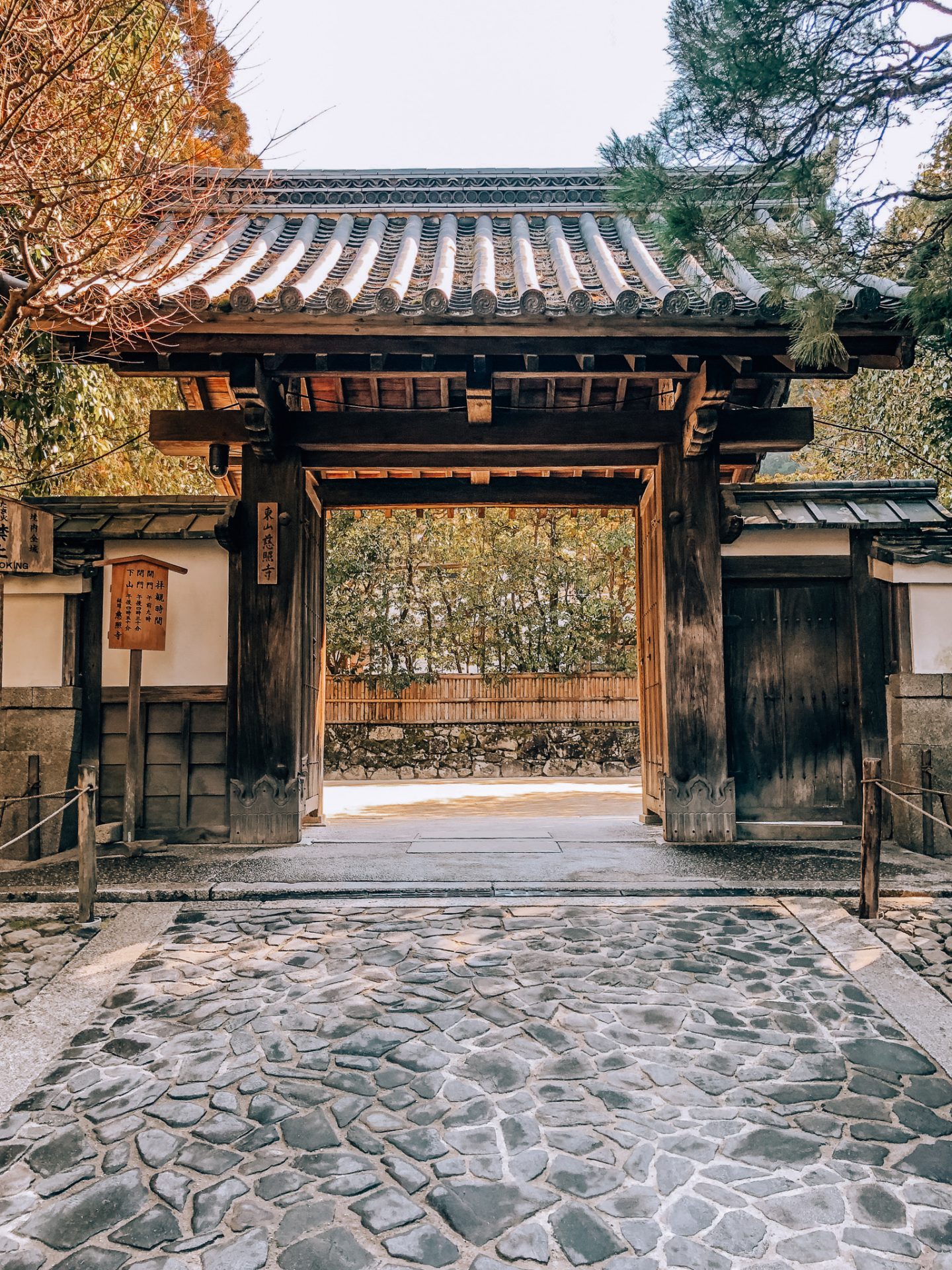

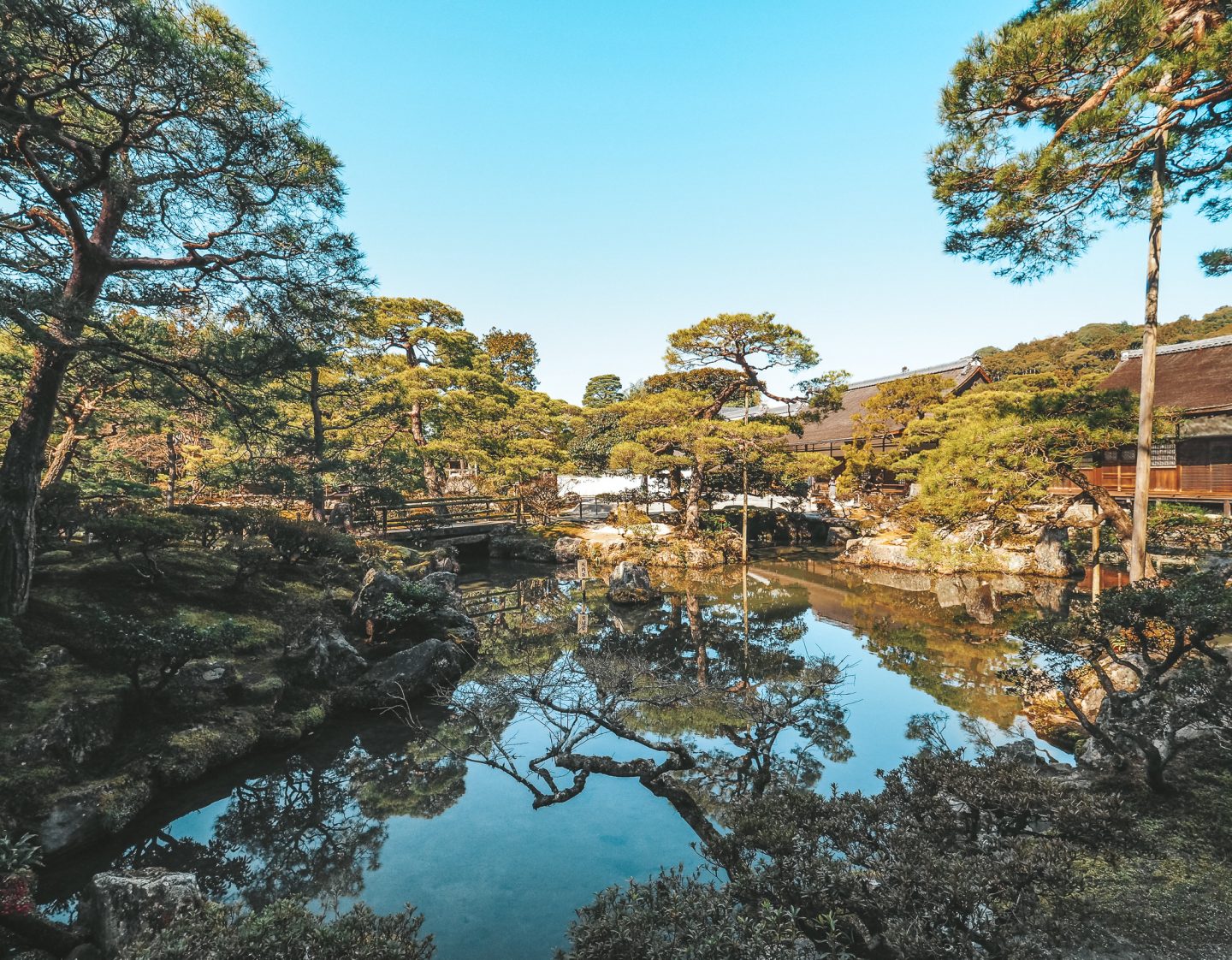
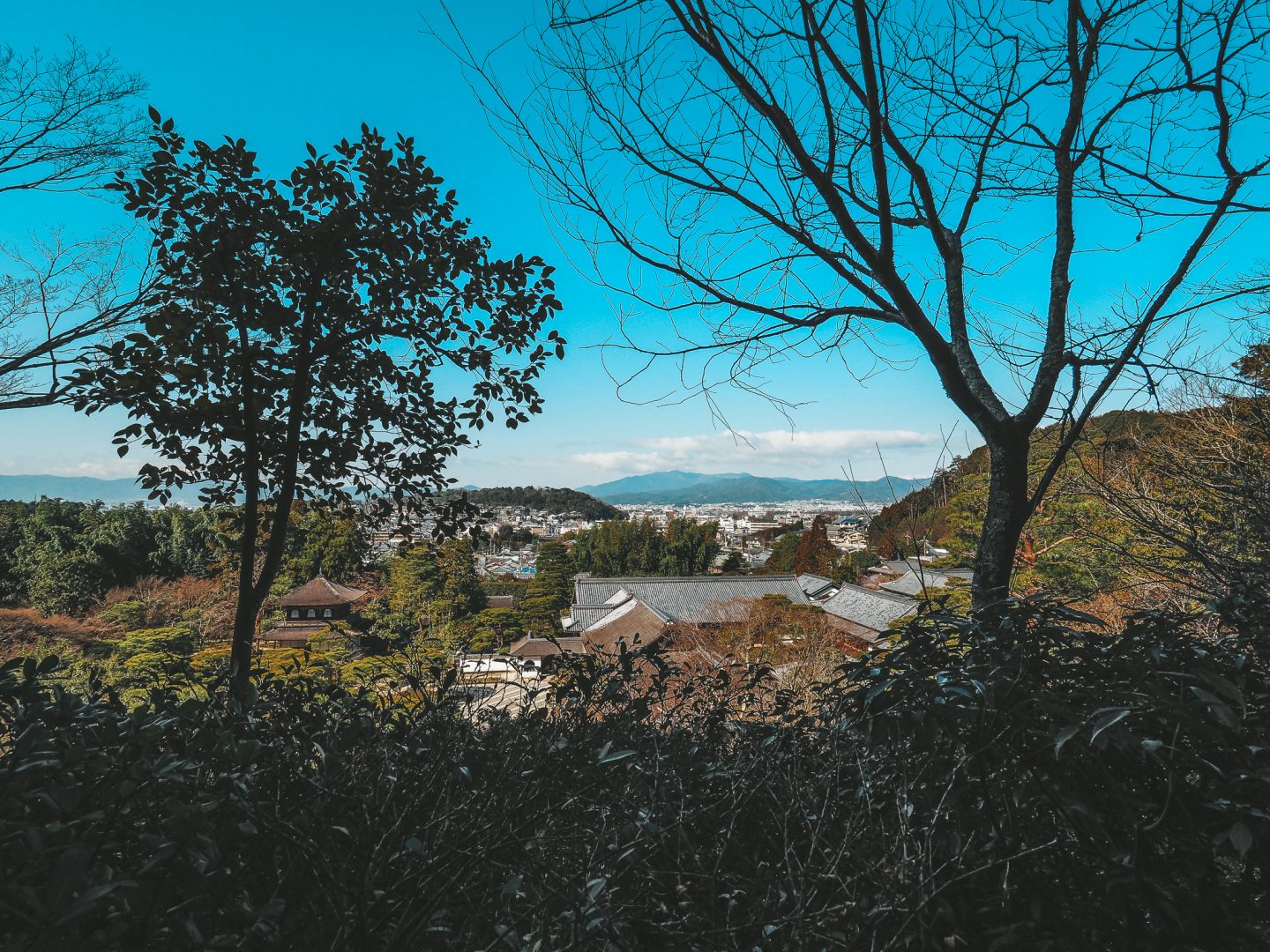
Philosopher’s Path
The path begins at Ginkakuji and runs about 2 km, all the way to the Nanjenzi Temple. The Philosopher’s Path offers visitors a peaceful stroll along a canal and is lined by hundreds of cherry trees. It makes for one of the most beautiful cherry blossom viewing spots (or hanami) during sakura season.
Named after a 20th century Japanese philosopher and Kyoto University professor who were thought to have used it daily for meditation, the path is now home to several boutiques and restaurants, as well as the occasional temple. This may be the perfect spot to have lunch and a short rest, before continuing on with your sightseeing. Recommended cafes include the Philosopher’s Cafe or Yojiya Cafe Ginkakujiten, whilst Monk is a great restaurant option for those looking for something more upmarket.
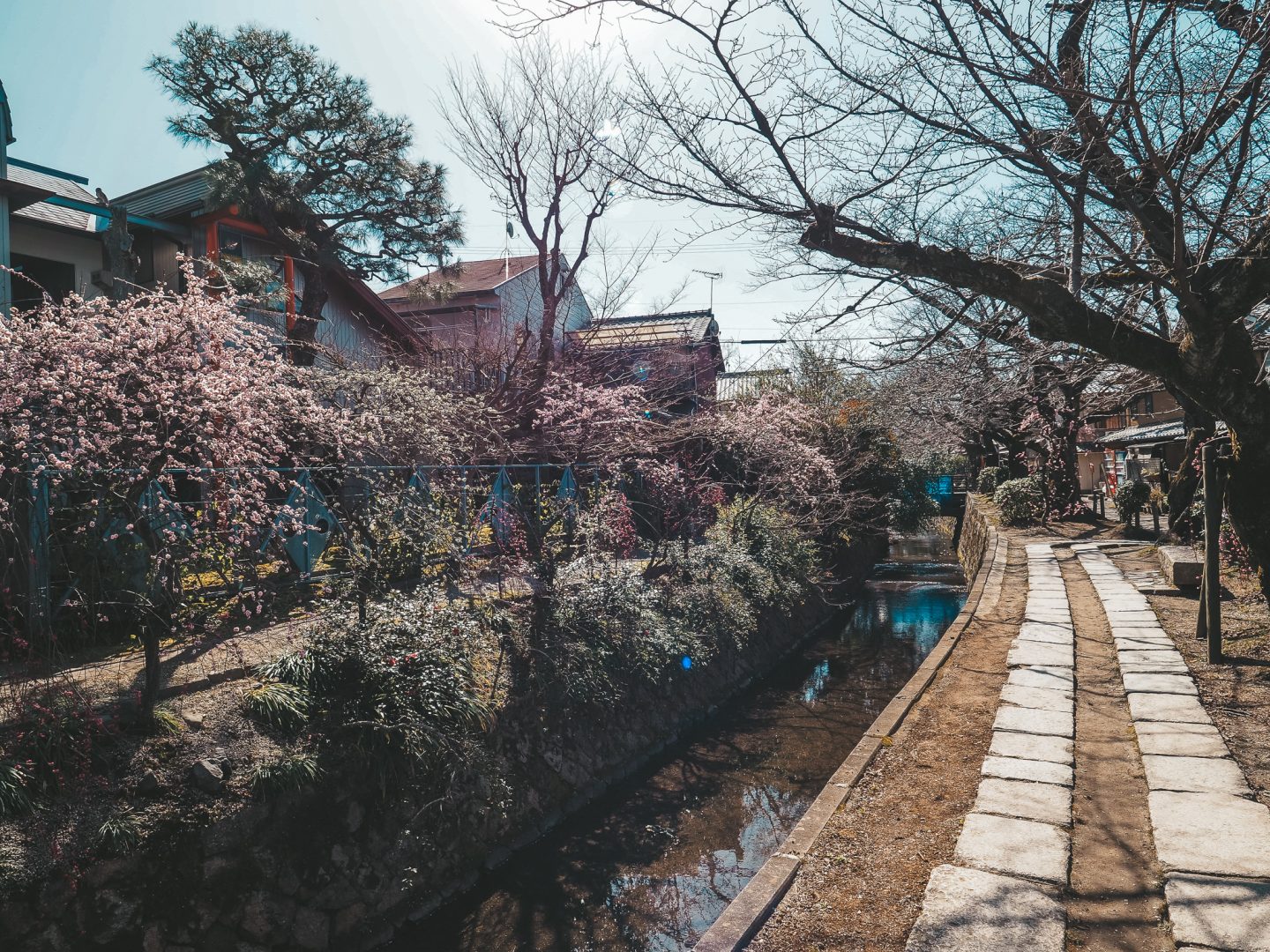
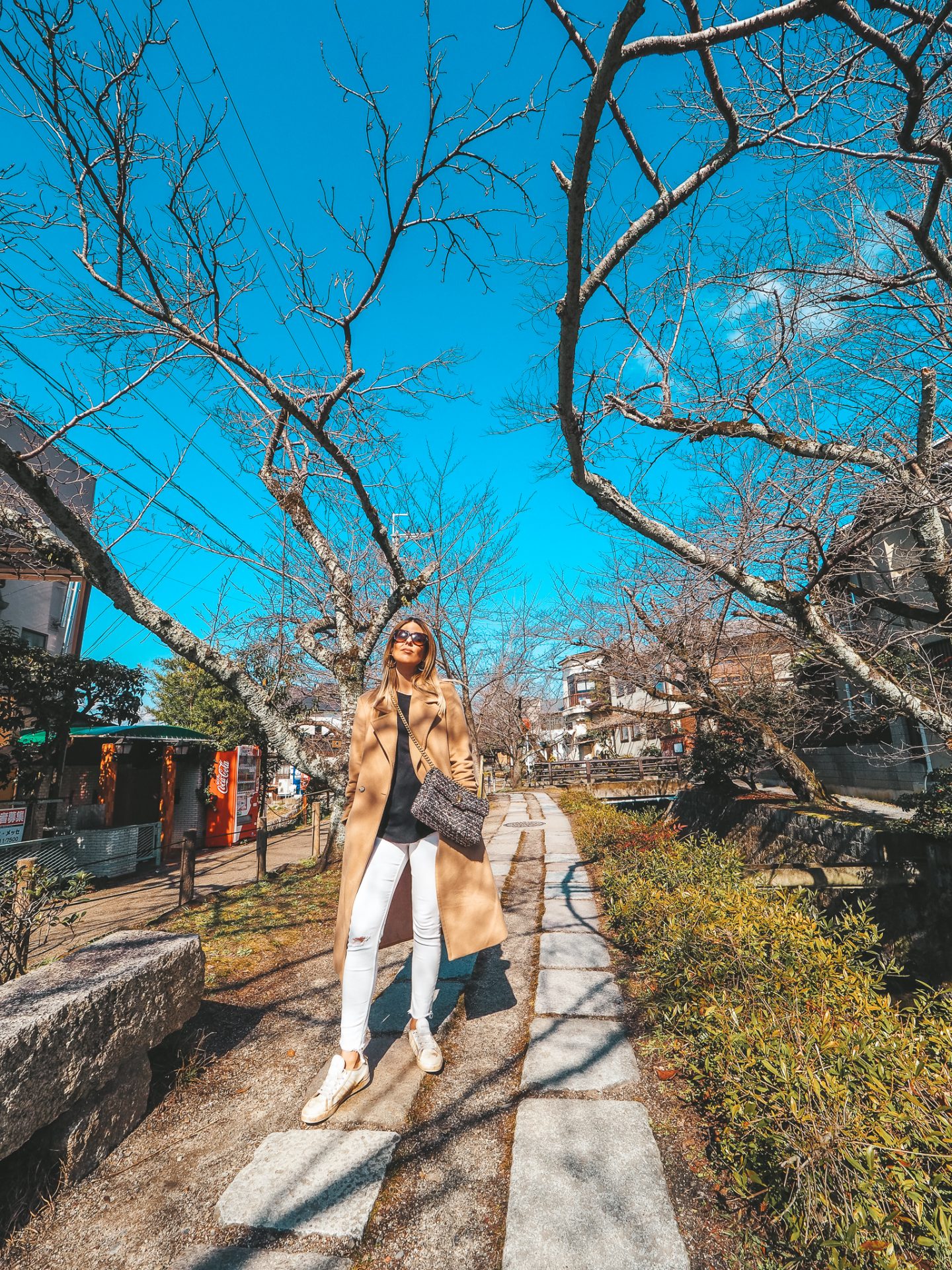
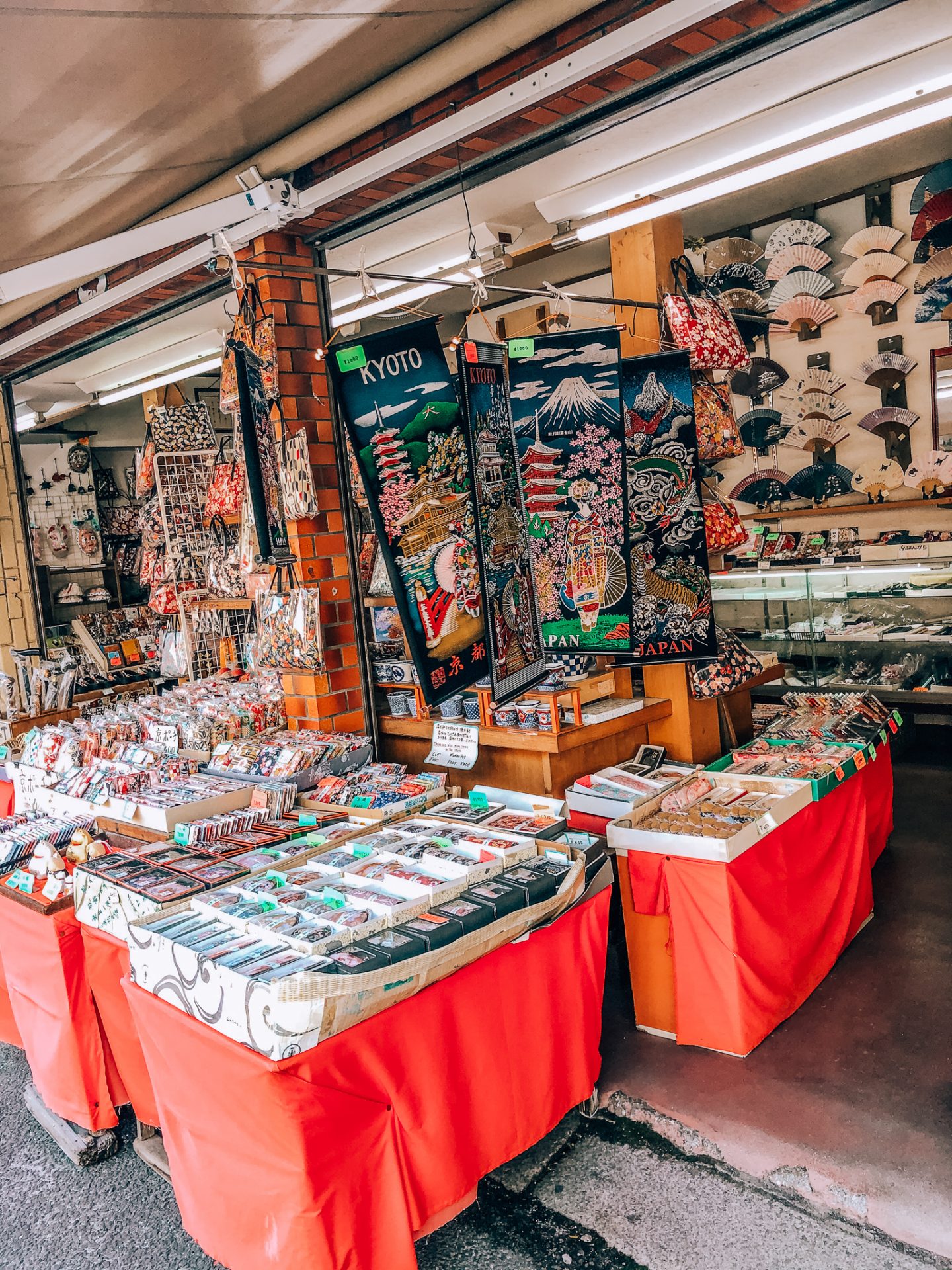
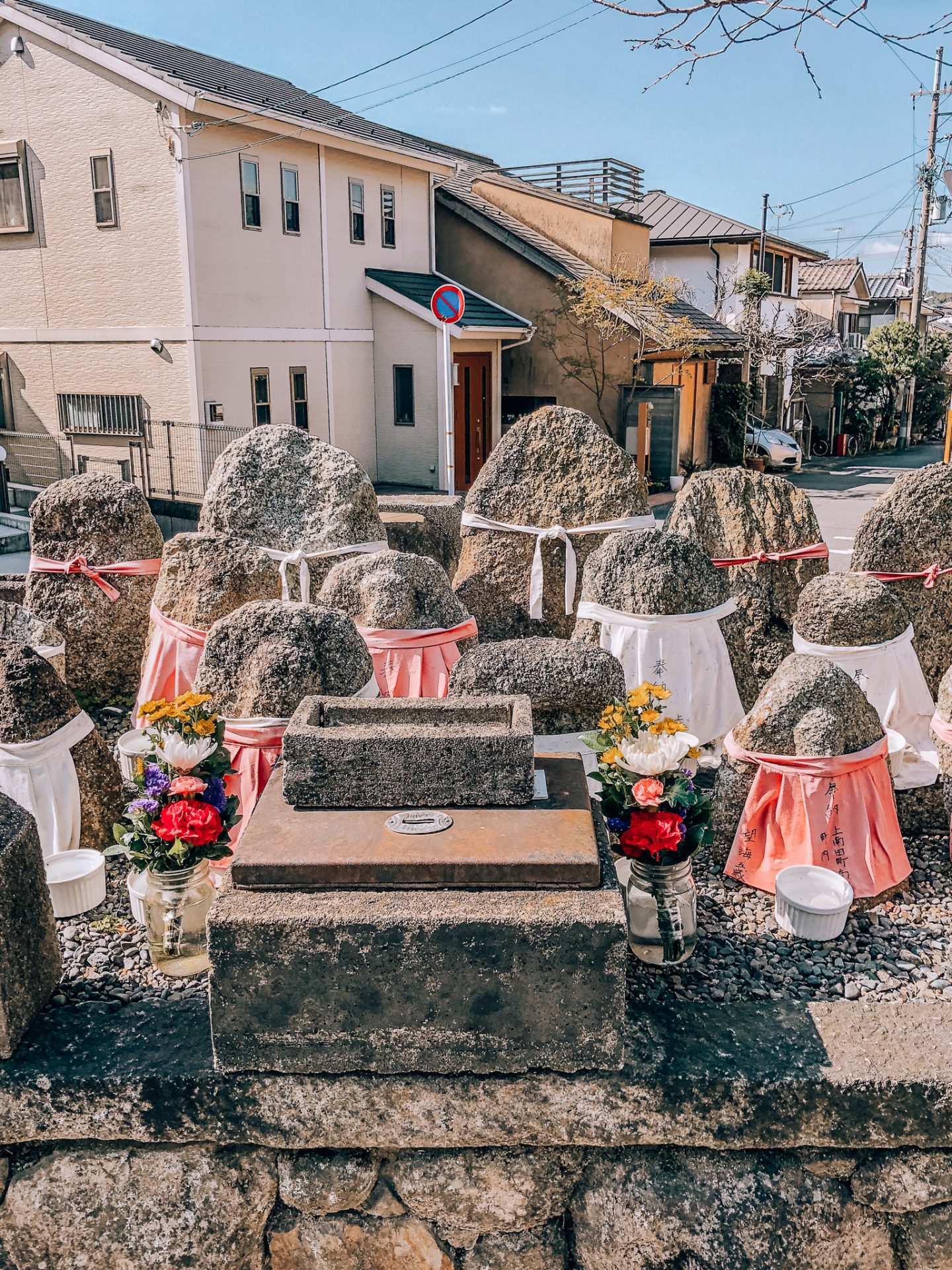
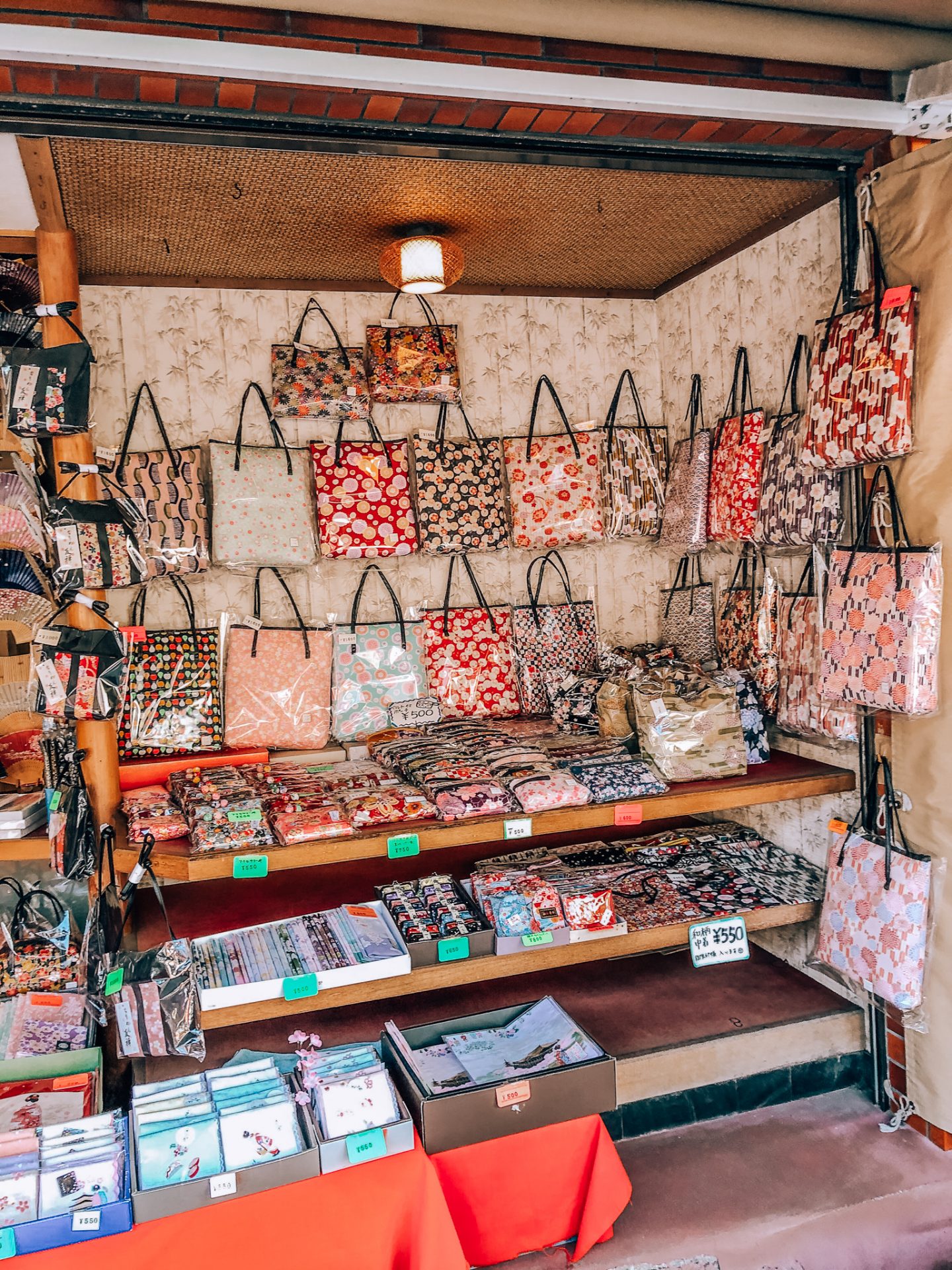
Nanzenji Temple
After a pit stop for lunch, continue walking along the Philosopher’s Path until you reach Nanzenji Temple – one of the most important temples in Japan. The entrance to the grounds is free of charge, however there are small fees to enter the individual temples. The first thing will visitors will note is the large gate at the entrance, which was constructed in 1628 for soldiers who died in the siege of Osaka Castle in 1615. That being said, the highlight of the temple was a stunning large brick aqueduct that passes through the temple grounds, constructed to carry water and goods between Kyoto and Lake Biwa.
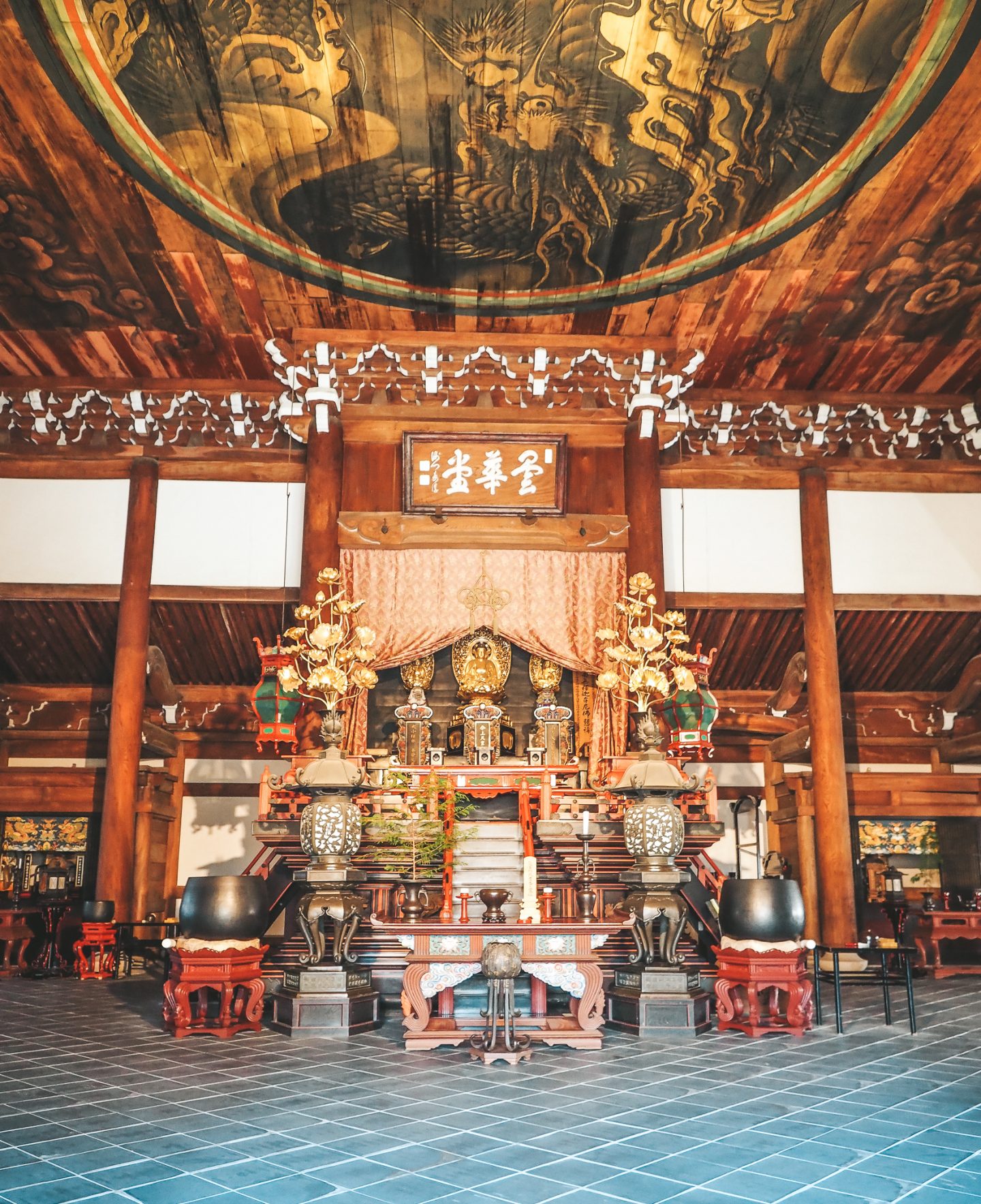
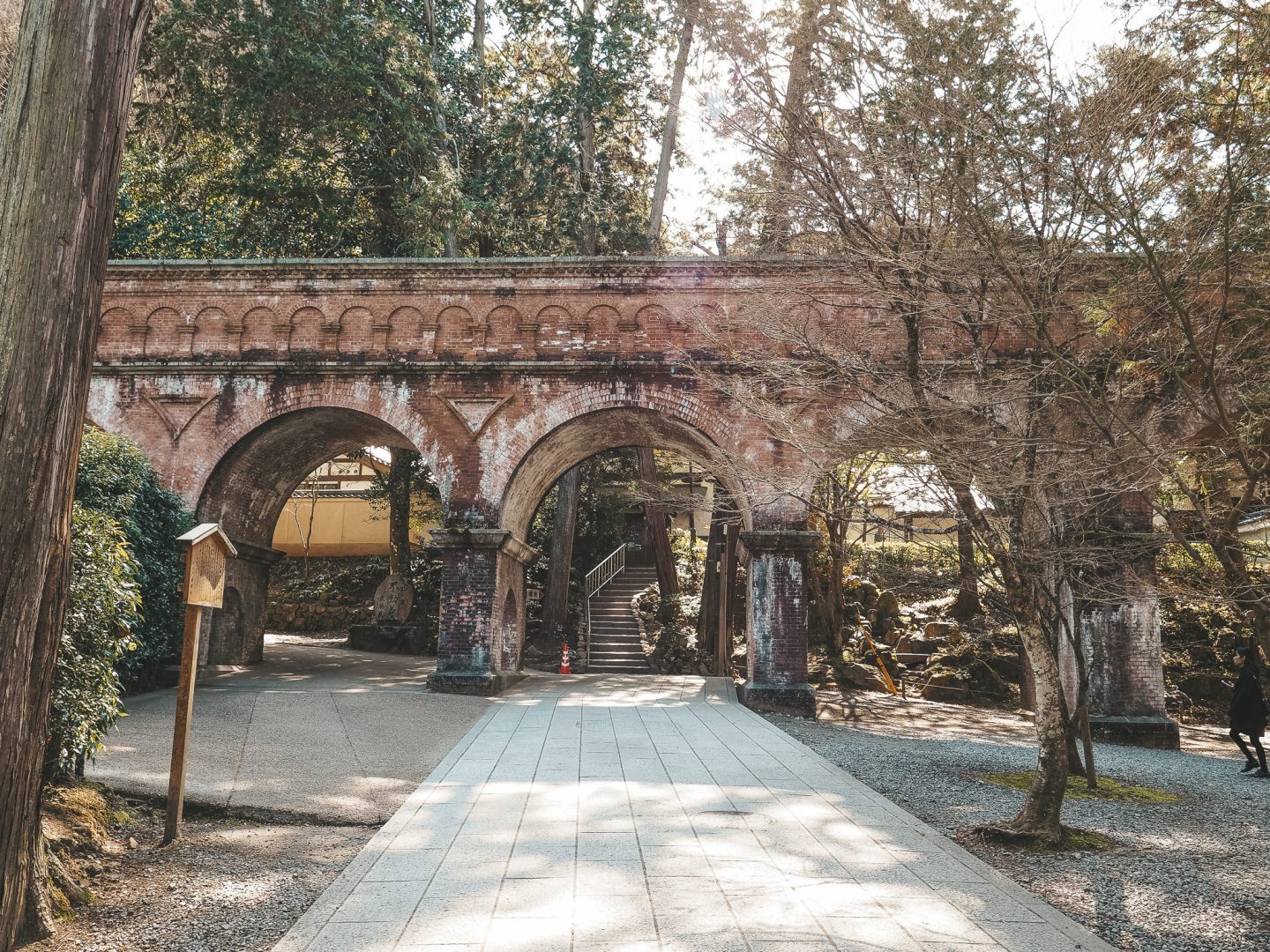
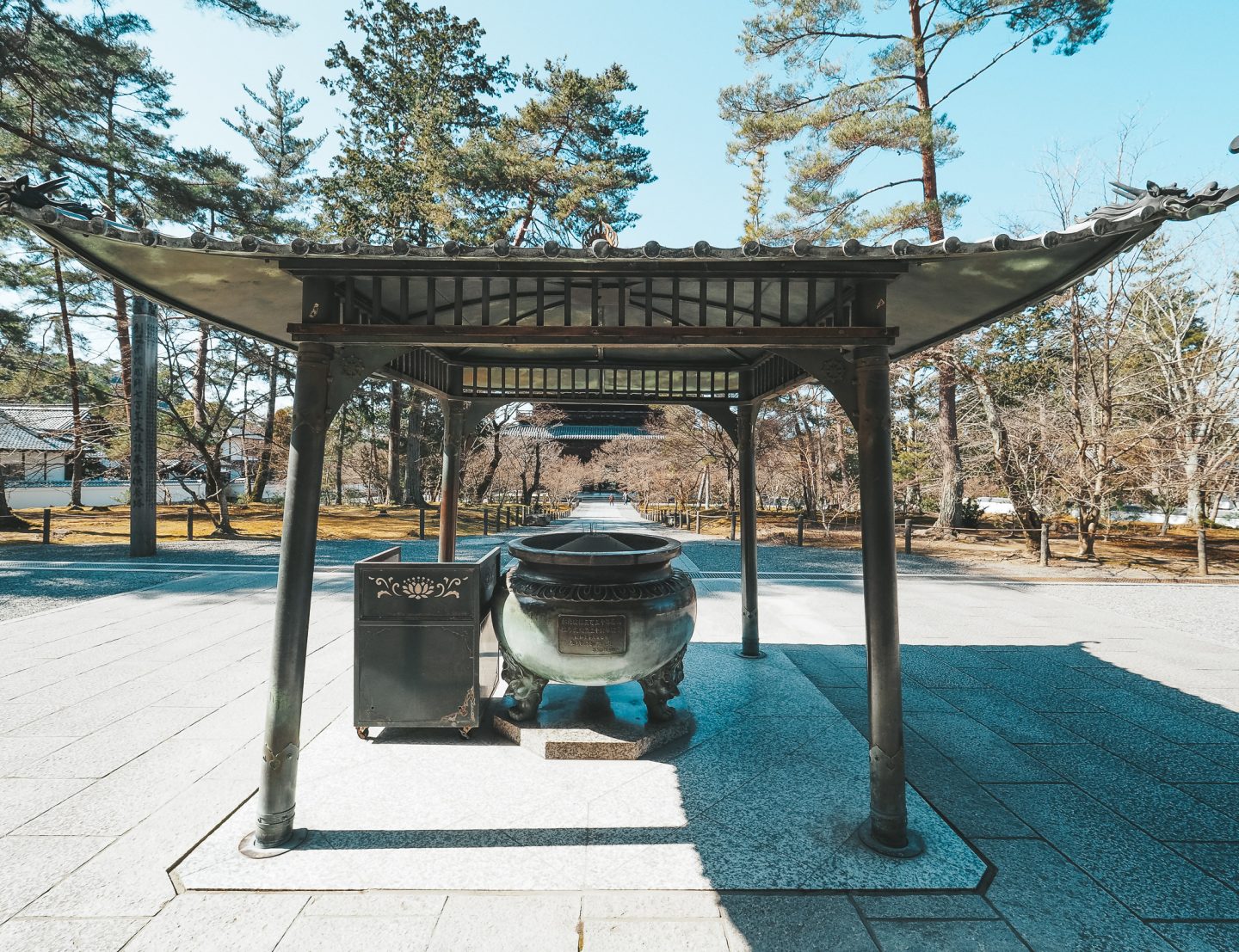

Keage Incline
From Nanzenji, it was a quick 10 minute walk to the Keage Incline. Admittedly, I would say this can be skipped if not travelling in cherry blossom season as this is a site most known for being one of the best hanami (or flower viewing sites).
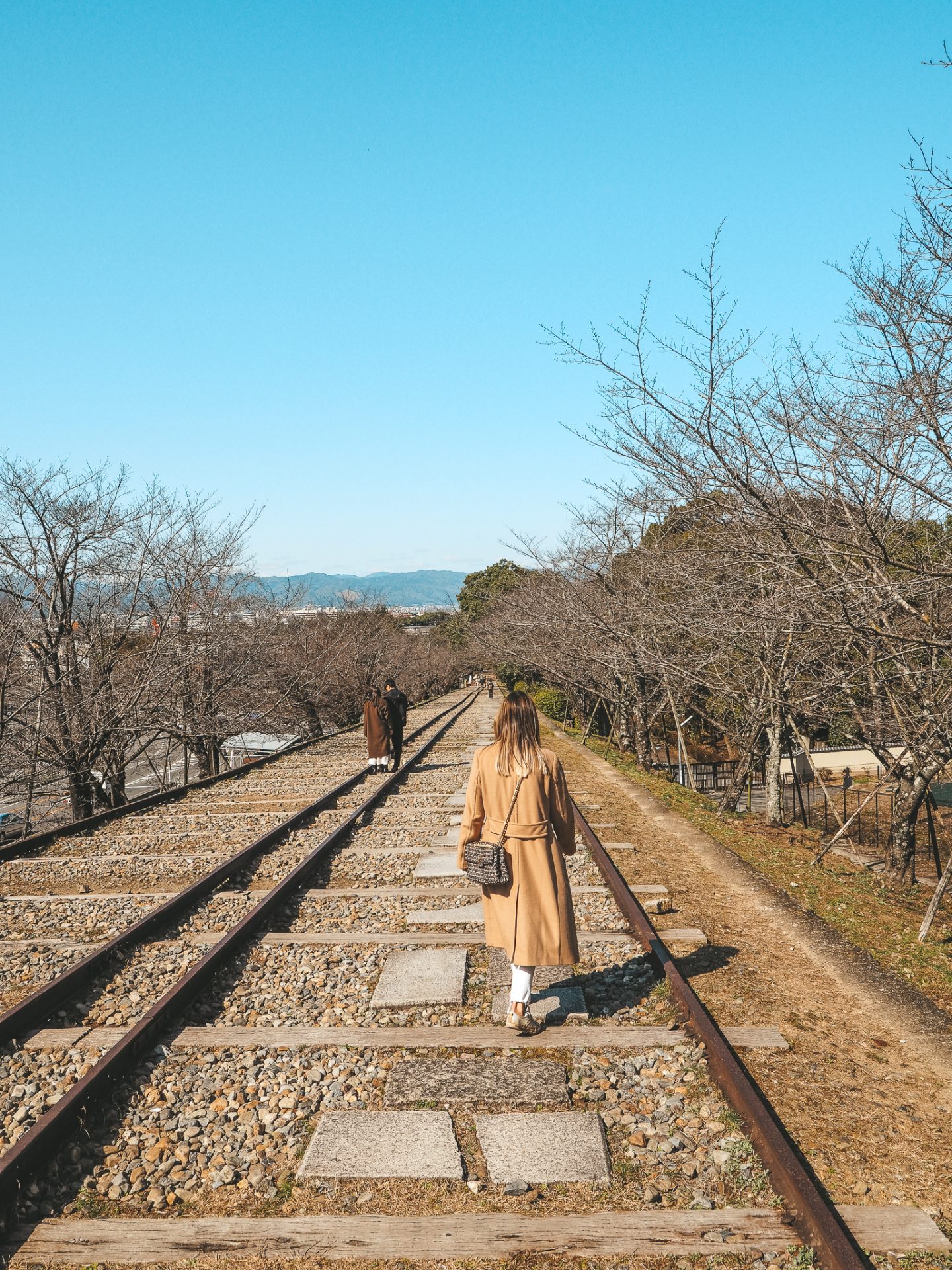
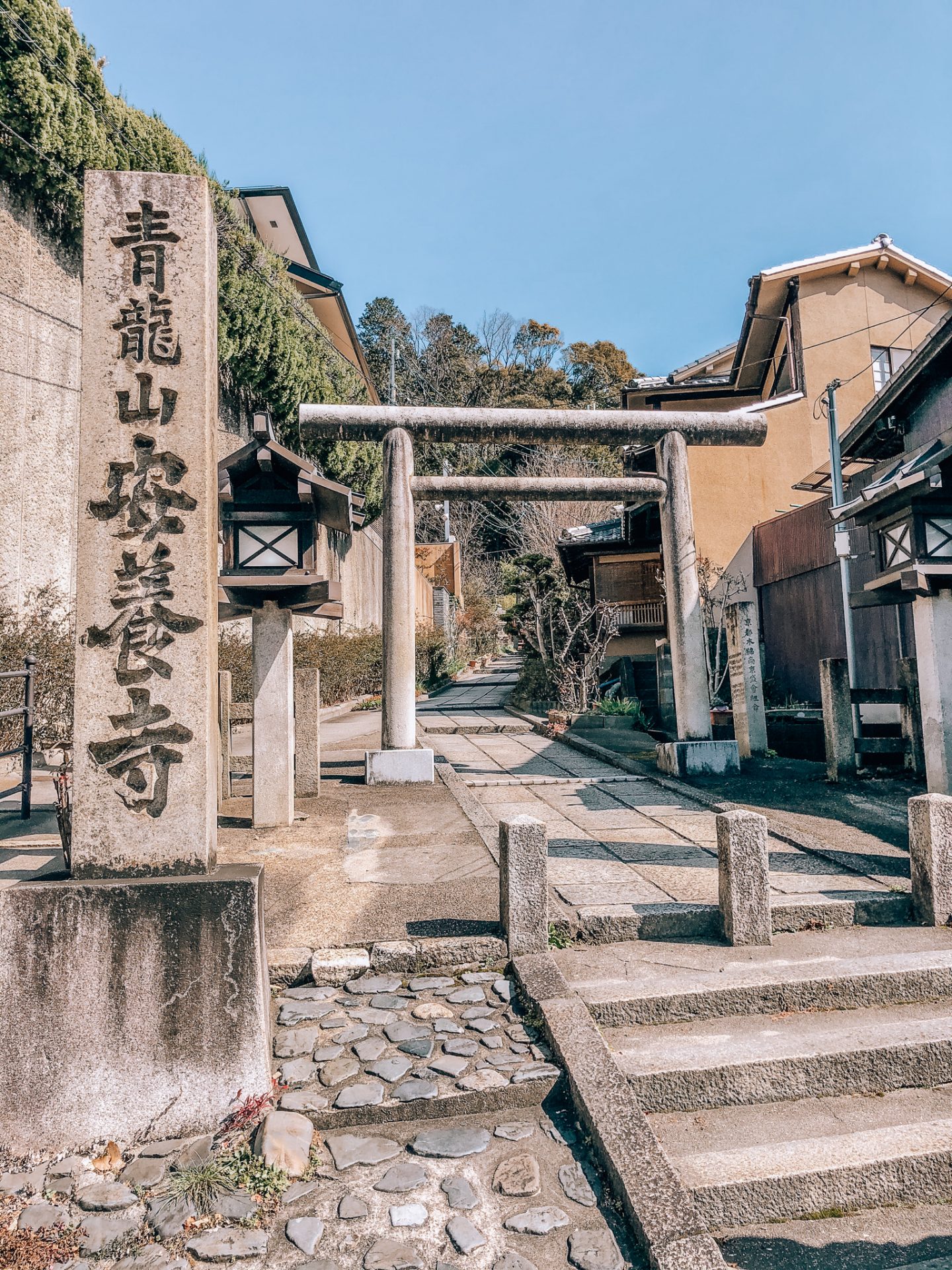
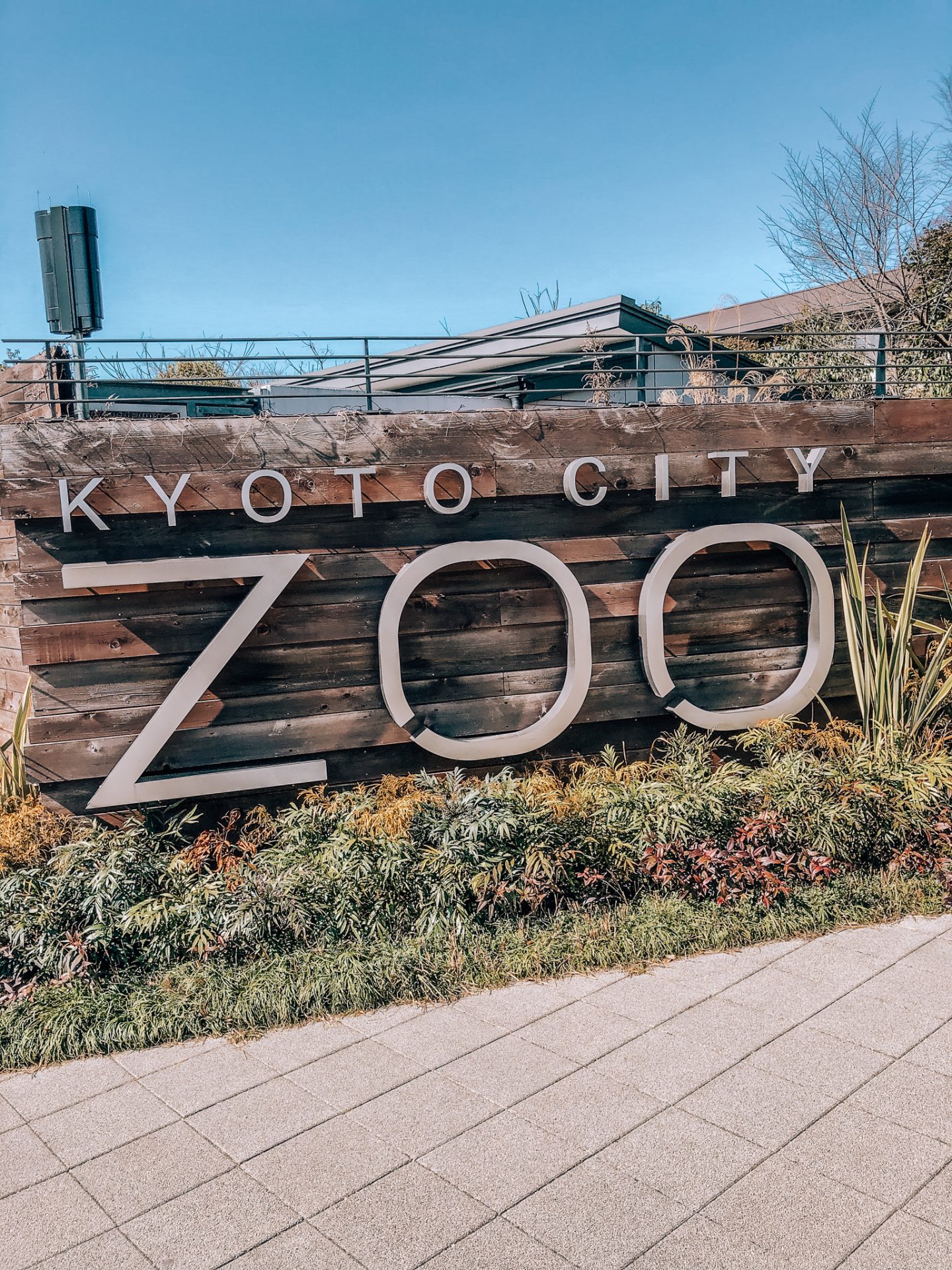
Heian Shrine
From the Keage Incline, we continued our walk to the Heian Shrine. For those that are interested, the Kyoto City Zoo is situated between the two and could also be slotted into this itinerary. If not, it’s on to the Heian Shrine, my favourite of the day. The Shrine stands out for its beautiful colours and was modeled after the ancient Imperial Palace. Interestingly, Heian is the former name of Kyoto and the shrine was built on the 1100th occasion of the capital’s foundation in Kyoto. Admission to the Heian Shrine is free, however the gardens charge an admission fee of 600 yen.
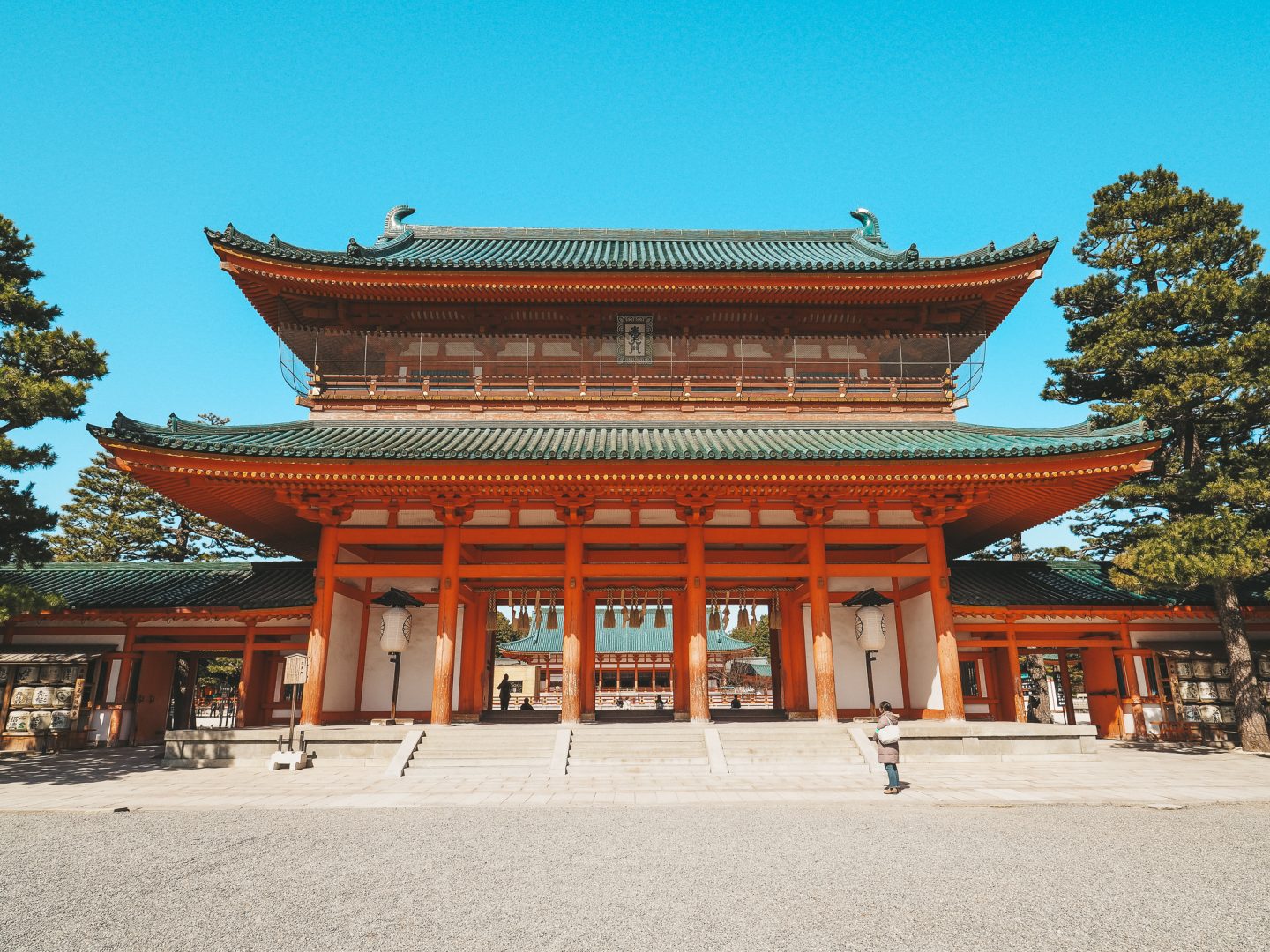
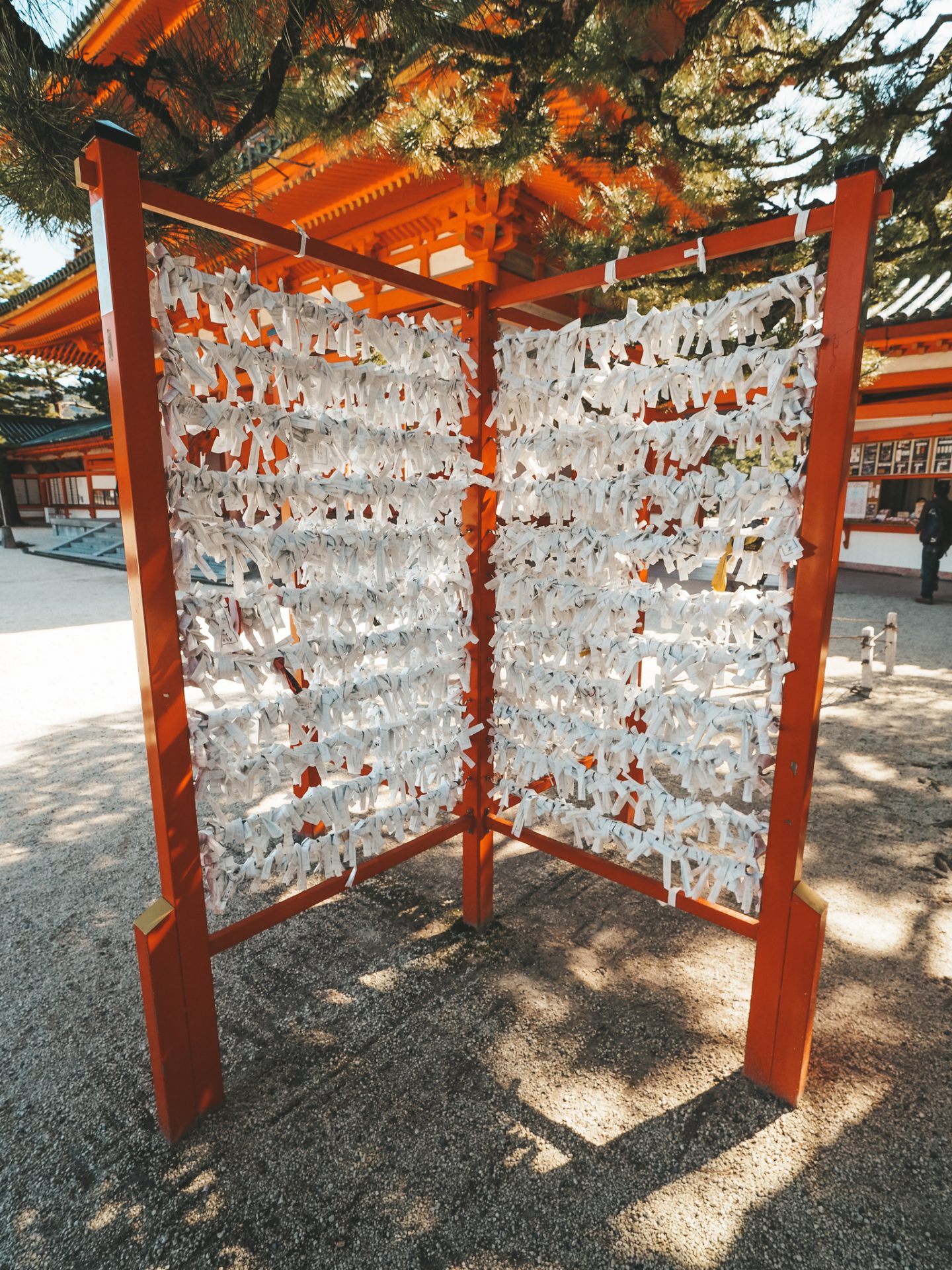

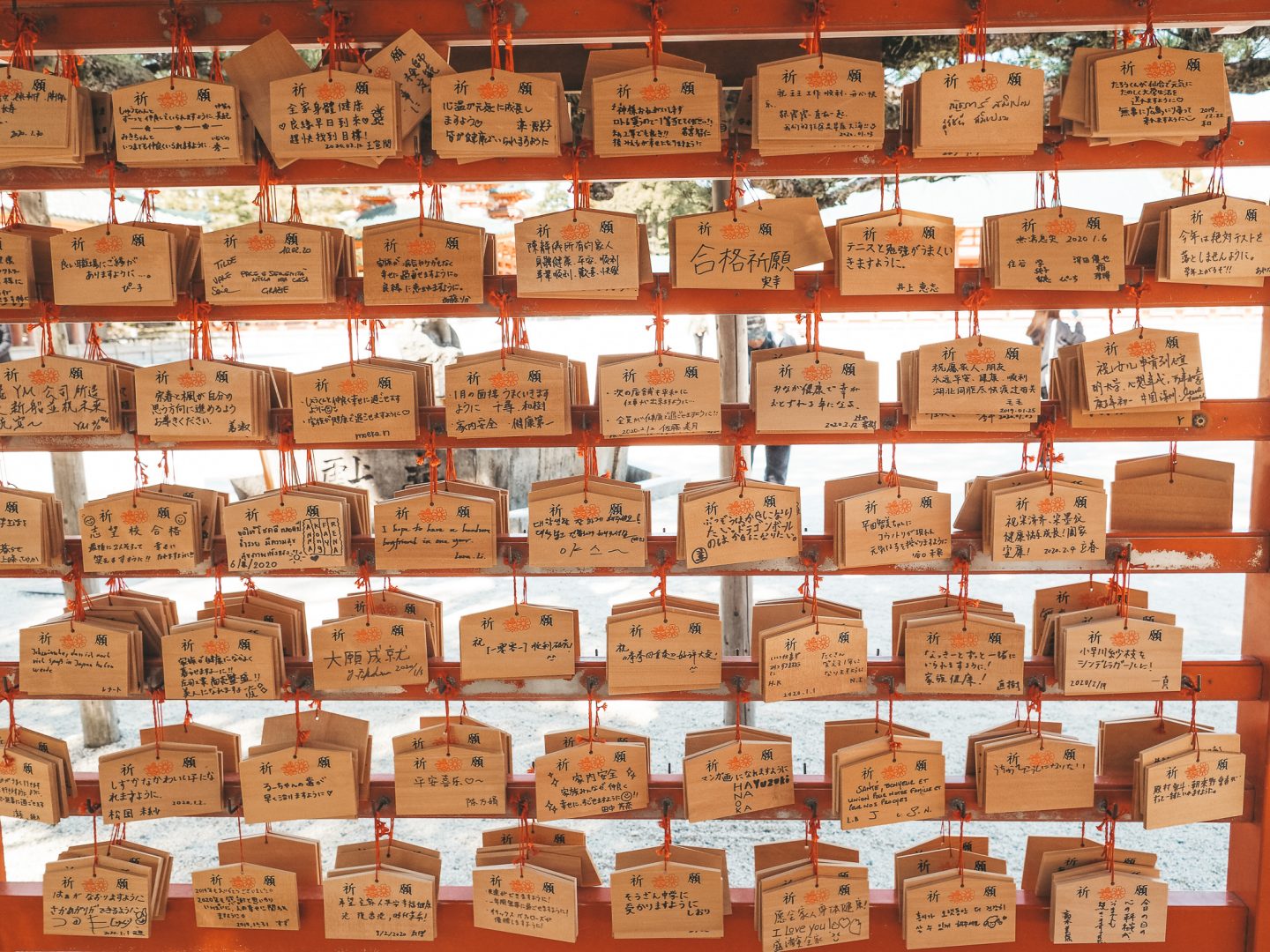
Starbucks Coffee Kyoto Okazaki Tsutaya Bookstore
I confess that I am one of those tourists who looks for a Starbucks in whichever country I’m in – I find it quite comforting in that it’s a little bit of familiarity no matter the country I’m in. Just opposite the Heian Shrine was a conveniently located Starbucks, and I mention it here in my Kyoto itinerary purely because it is located in a beautiful bookstore and it is worth visiting for the bookstore alone. Kyoto Okazaki Tsutaya Bookstore is dedicated to inspire and bring to you ‘things that move the soul’.

Higashiyama Streets
After indulging in your sakura latte and looking through some of the most inspiring books on Japanese culture and philosophy, continue your walk until you spot the Park Hyatt Kyoto. If you are already booked to stay here during your time in Kyoto, then it is perfectly located for you to make a quick pitstop to freshen up. If not, once you have reached the Park Hyatt Kyoto, you’ll probably note that you have just arrived at the start of Higashiyama Streets.
The Higashiyama District is one of the city’s best preserved historic districts and is a great place to experience traditional old Kyoto. The small boutiques sell a plethora of local goods and souvenirs, and the streets are lined with quaint little cafes and restaurants.
There is a reason I have left this to the end of the day, even though some of the stores may be closed. The Higashiyama District is incredibly busy with tourists throughout the day, and this continues up until around an hour after sunset. Depending on the time of year you visit, this itinerary should get you there just in time for sunset. The tourists will begin to dwindle and you stand to take some incredible pictures.
This is a personal decision that I leave to the readers. If you would prefer visiting a little earlier when more shops are open, then you might need to eliminate one or two of the points in the agenda above. On the other hand, if you would prefer to visit the Higashiyama District when things are a little quieter and be able to take some gorgeous nighttime shots without crowds of people around, then the early evening is perfect.

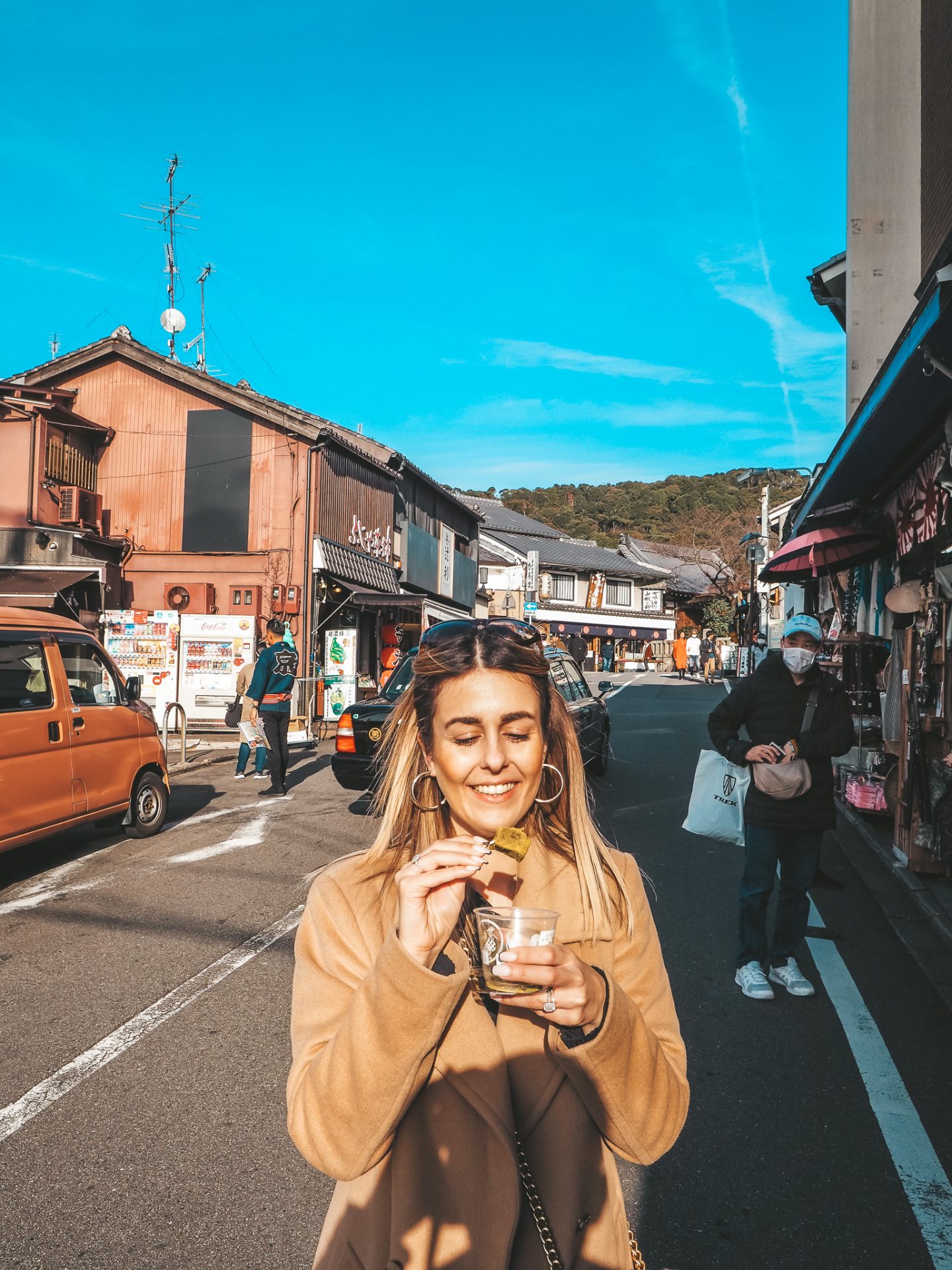

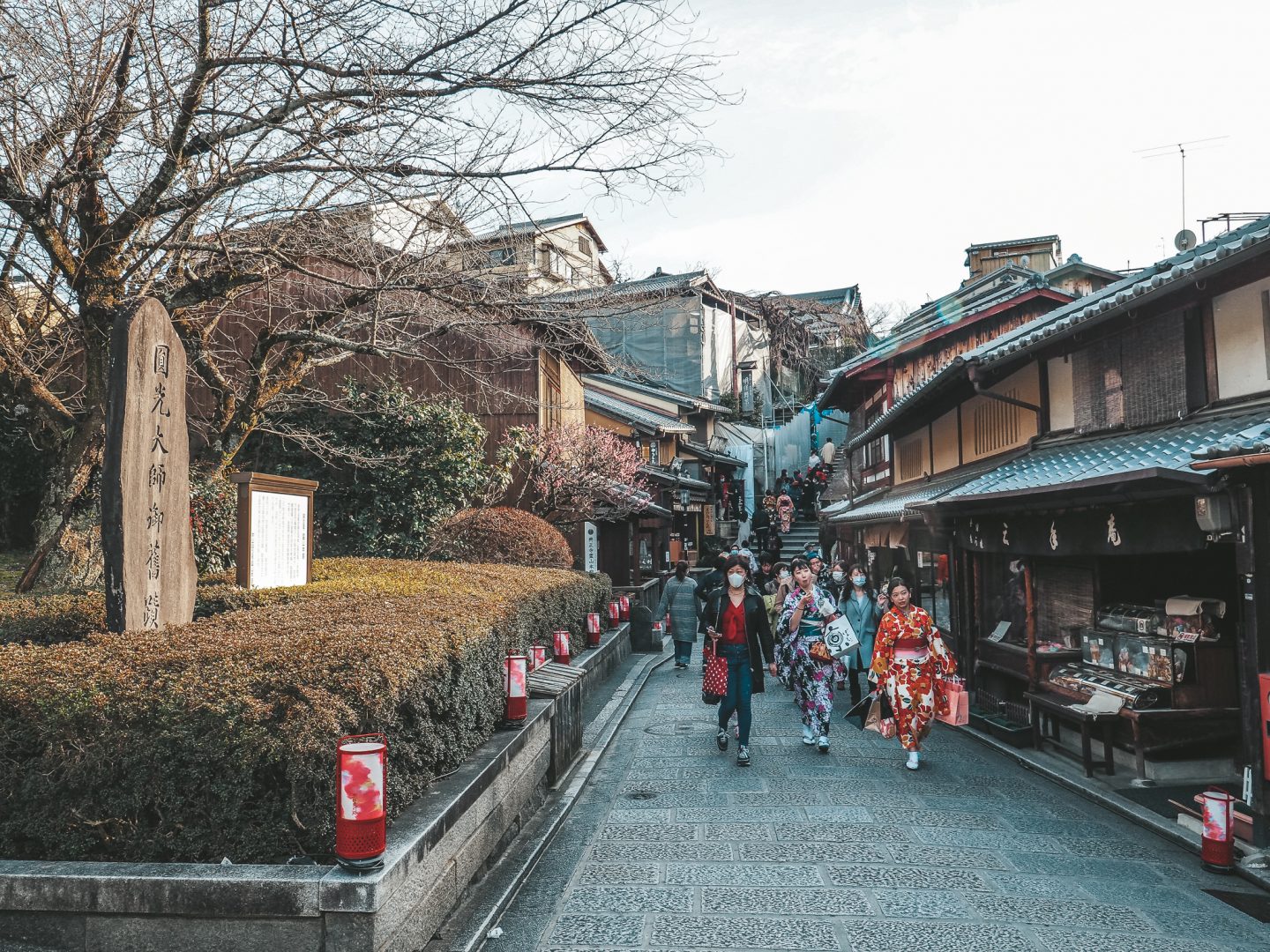
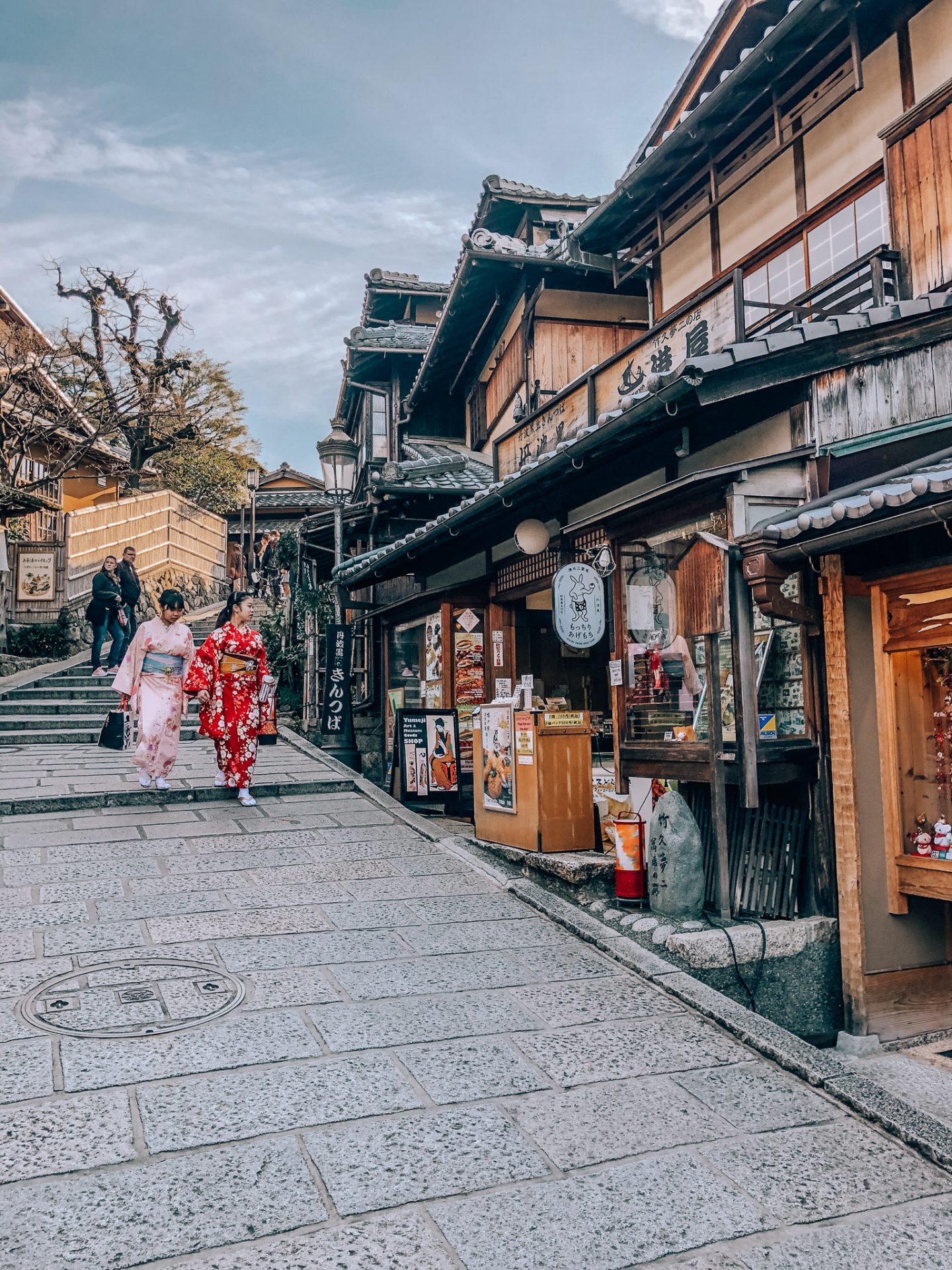
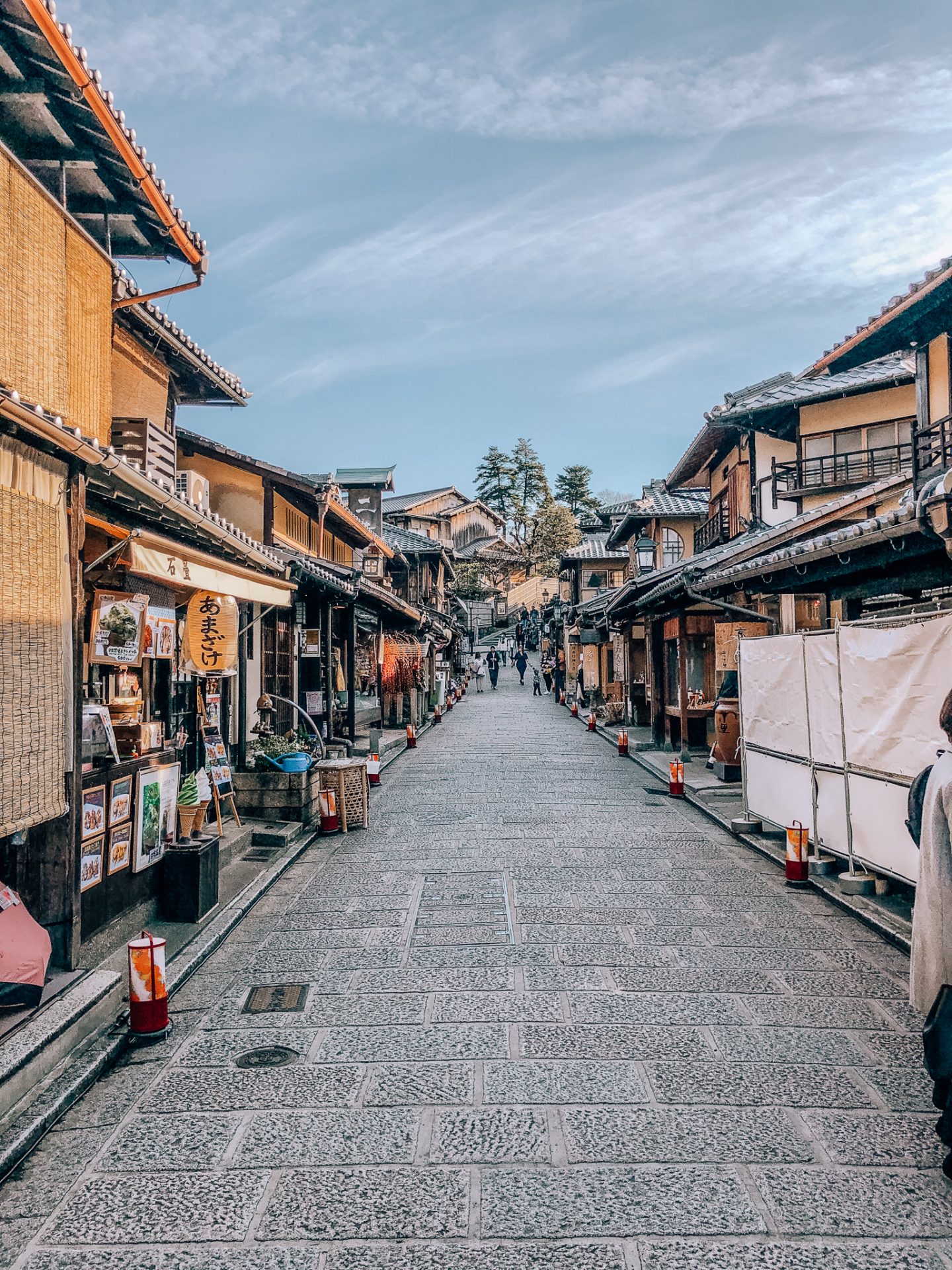
Gion Night Walk
I’m ending the day with an optional extra. Today was the first of two packed days and I can definitely appreciate that most will feel exhausted by this point. All that said, I couldn’t help but add this little suggestion at the end for those who want to explore a little bit of Kyoto nightlife. I also mention it because I did not do this and now wish I had.
From my research, it seems that the best way to make the most of this is to hire a local guide to find the best spots and improve your chances of spotting a real-life geisha! A guide can also advise on the best izakayas in town so that you can enjoy a good meal! You can find a guide through websites like Hihi or Kyoto Fun.
Kyoto Itinerary: Day II – Arashiyama District
| Time | Experience | Notes |
| 9am | Togetsukyo Bridge | Iconic landmark bridge Approximately 15 minutes away from Kyoto Station – take the JR Sagano/San-in Main Line to Saga-Arashiyama Station using your JR Pass Can also be reached by 30 minute bus from Kyoto Station bus terminal. Take Bus 28 to Arashiyama-Tenryuji-mae bus stop using your bus pass |
| 9:30am | Arashiyama Monkey Park Iwatayama | Walk 5 minutes from Togetsukyo Bridge to Arashiyama Monkey Park Iwatayama |
| 11am | Walk to Tenryuji | Walk takes approximately 20/25 minutes |
| 11:30am | Tenryuji Temple | Arashiyama‘s most important temple |
| 12pm | Bamboo Grove | Leave Tenryugi through the back entrance to enter this iconic attraction |
| 1230pm | Take train back to Kyoto Station from Saga-Arashiyama Station | Use JR Pass to travel from Saga-Arashiyama Station back to Kyoto Station on the JR San-In Line |
| 1pm | Lunch | There are plenty of restaurants at Kyoto Station for travellers to explore – our favourite was a small soba noodle restaurant called Tagoto. |
| 2pm | Take train to Inari Station | Use your JR Pass on the Nara Line and stop at Inari Station |
| 2:15pm | Fushimi Inari-taisha Shrine | A world renowned shrine, known for its distinctive orange columns |
| 4pm | Take train to back to Kyoto Station | Use your JR Pass on the Nara Line and stop at Kyoto Station |
| 4:30pm | Kyoto Tower | Moments away from Kyoto Station Admire the view from the observation deck of the tallest building in Kyoto |
| 6pm | Avanti Department Store | In your last few hours in Kyoto, you may want to relax a little at Avanti department store just by the station and pick up some Japanese goodies |
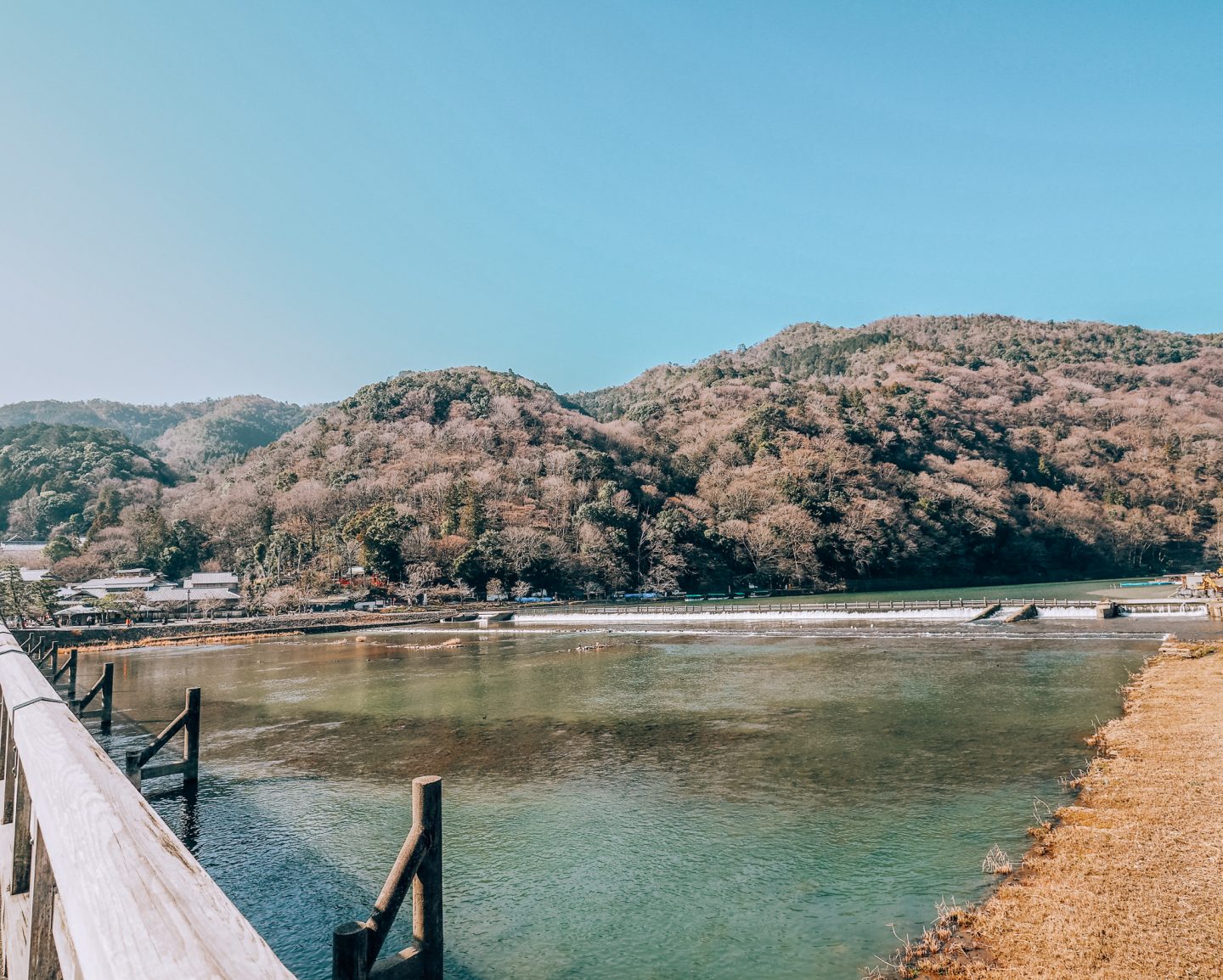
Togetsukyo Bridge
Day II of this jam-packed Kyoto 2 day itinerary takes it a little easier than Day I – but not much. We start the day with this iconic landmark bridge just moments away from Saga-Arashiyama Station.
The Togetsukyo Bridge is renowned in Japan, and is surrounded by many shops, restaurants and other temples – including the Tenryuji Temple if you so fancy it (see further down). Boats are also available for rent on the river and the landscape is particularly stunning during cherry blossom season.
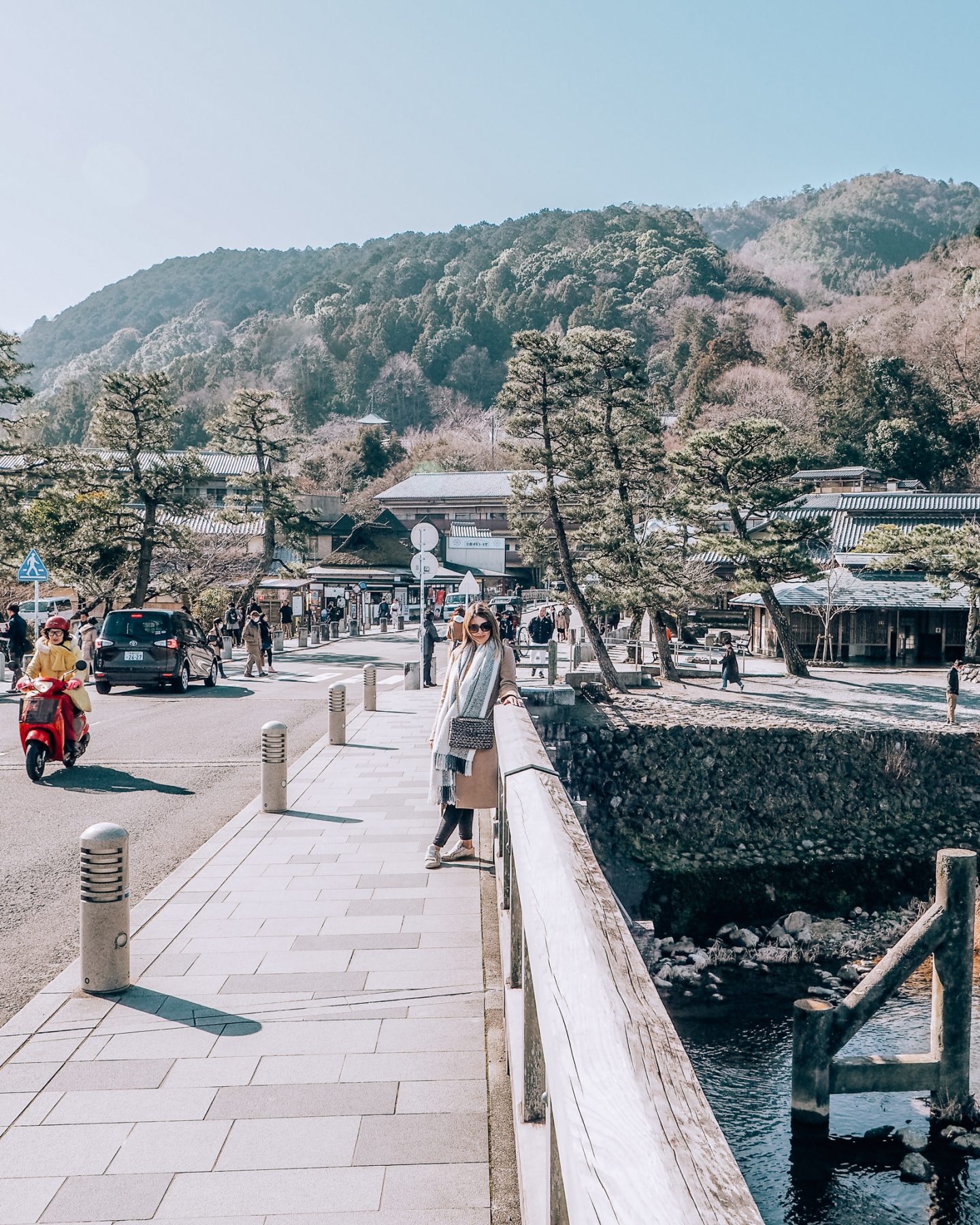
Arashiyama Monkey Park Iwatayama
Just a short 10 minute walk about from Togetsukyo Bridge is the Iwatayama Monkey Park – another of my top-rated experiences during my time in Japan. Admission costs 550 yen and there is an uphill walk to get to the main attraction which may put some travellers off, but the experience is well worth it. Once you’ve climbed the hill and reached the top, you’ll be surrounded by the approximate 120 Japanese Macaque monkeys that reside around the observation deck. For a few extra yen, you can feed the monkeys from a small hut at the top.
Whilst the monkeys in their natural habitat are definitely the main attraction, the view from the top is quite something and offers a panoramic view of Kyoto. As with almost everywhere in Japan, this is particularly stunning during sakura season and when the trees begin to redden in the autumn.
A word of caution – please respect the rules when it comes to interacting with the monkeys: no feeding, no touching and do not look them directly in the eye.
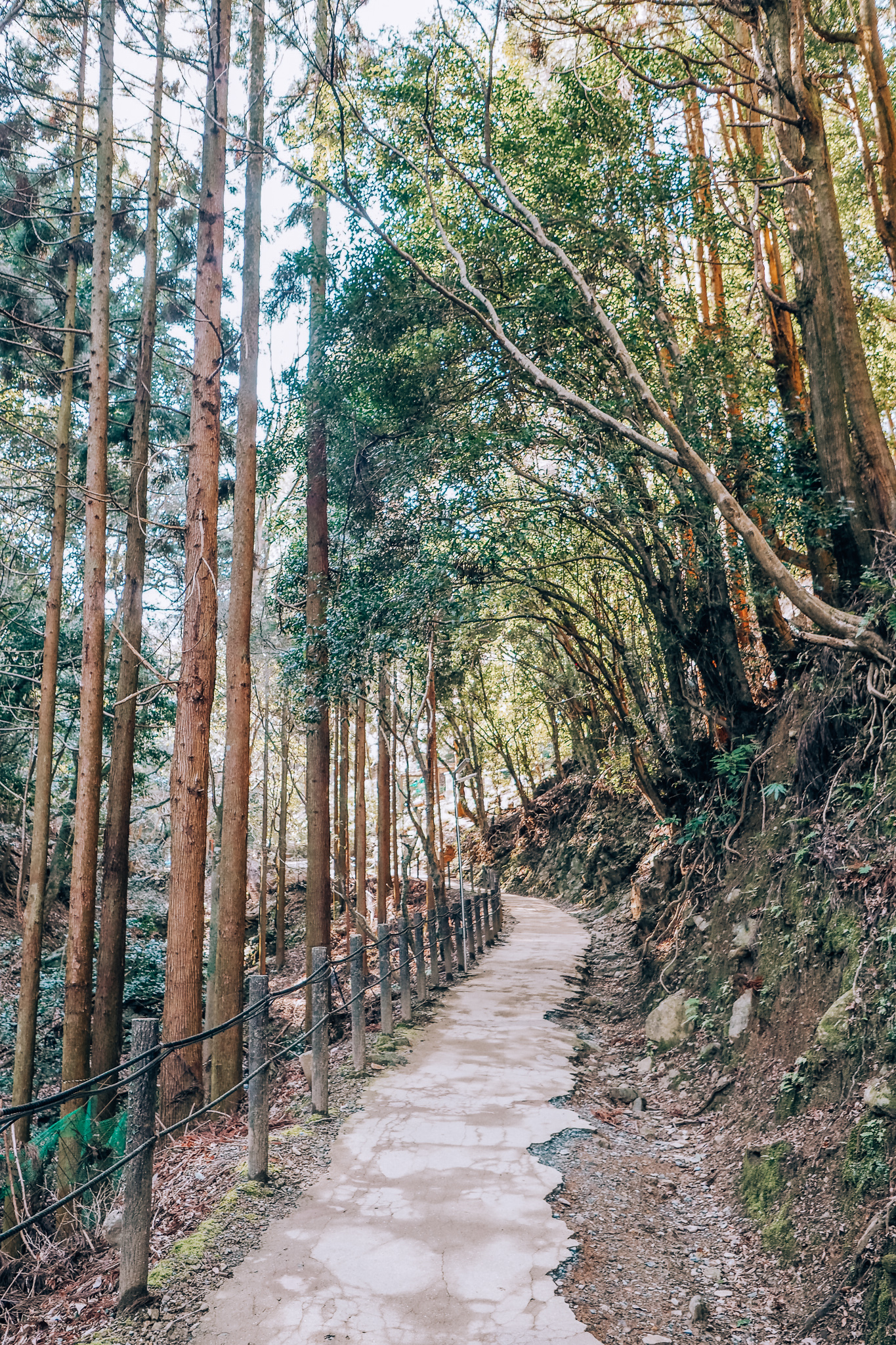
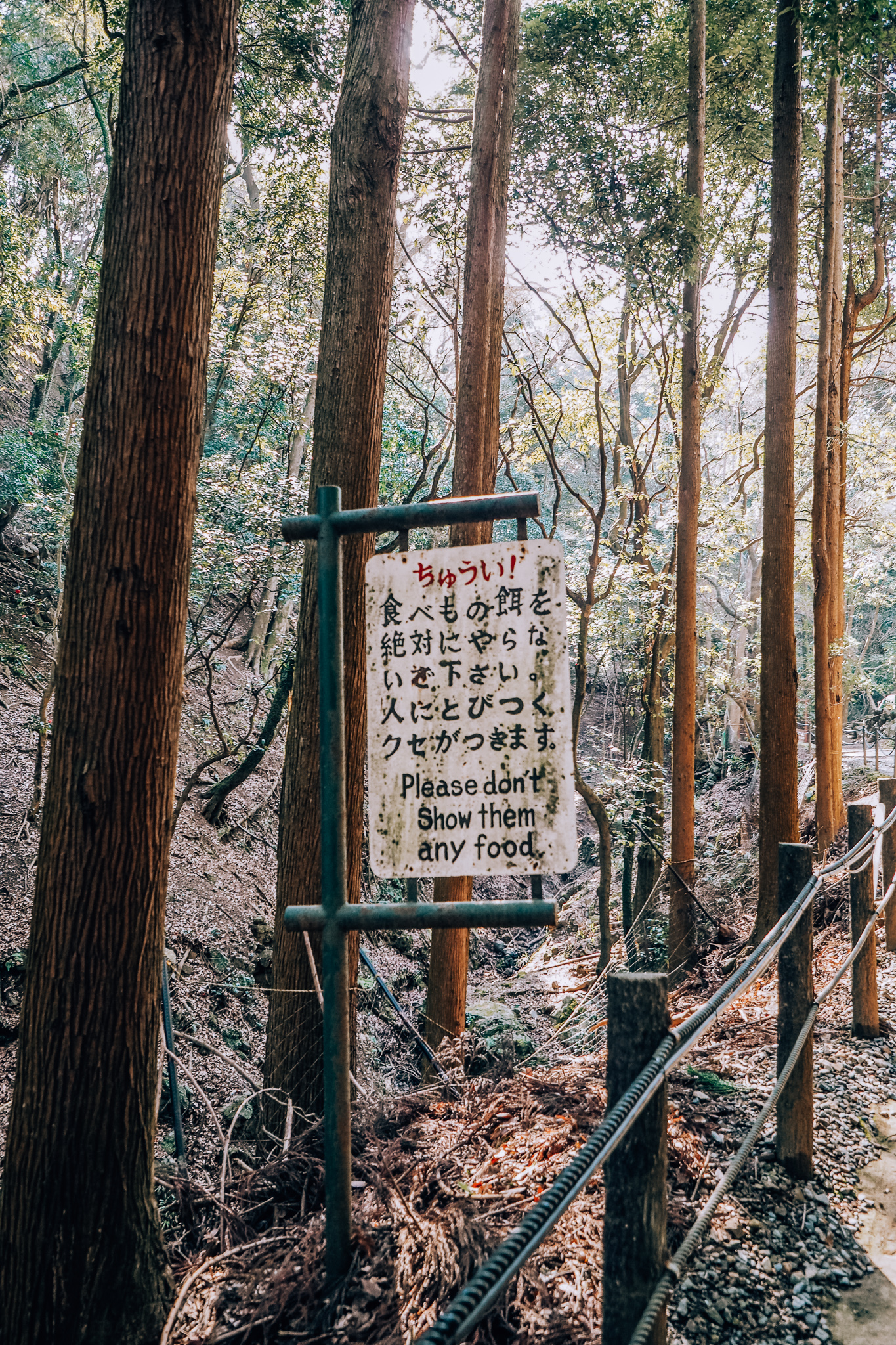
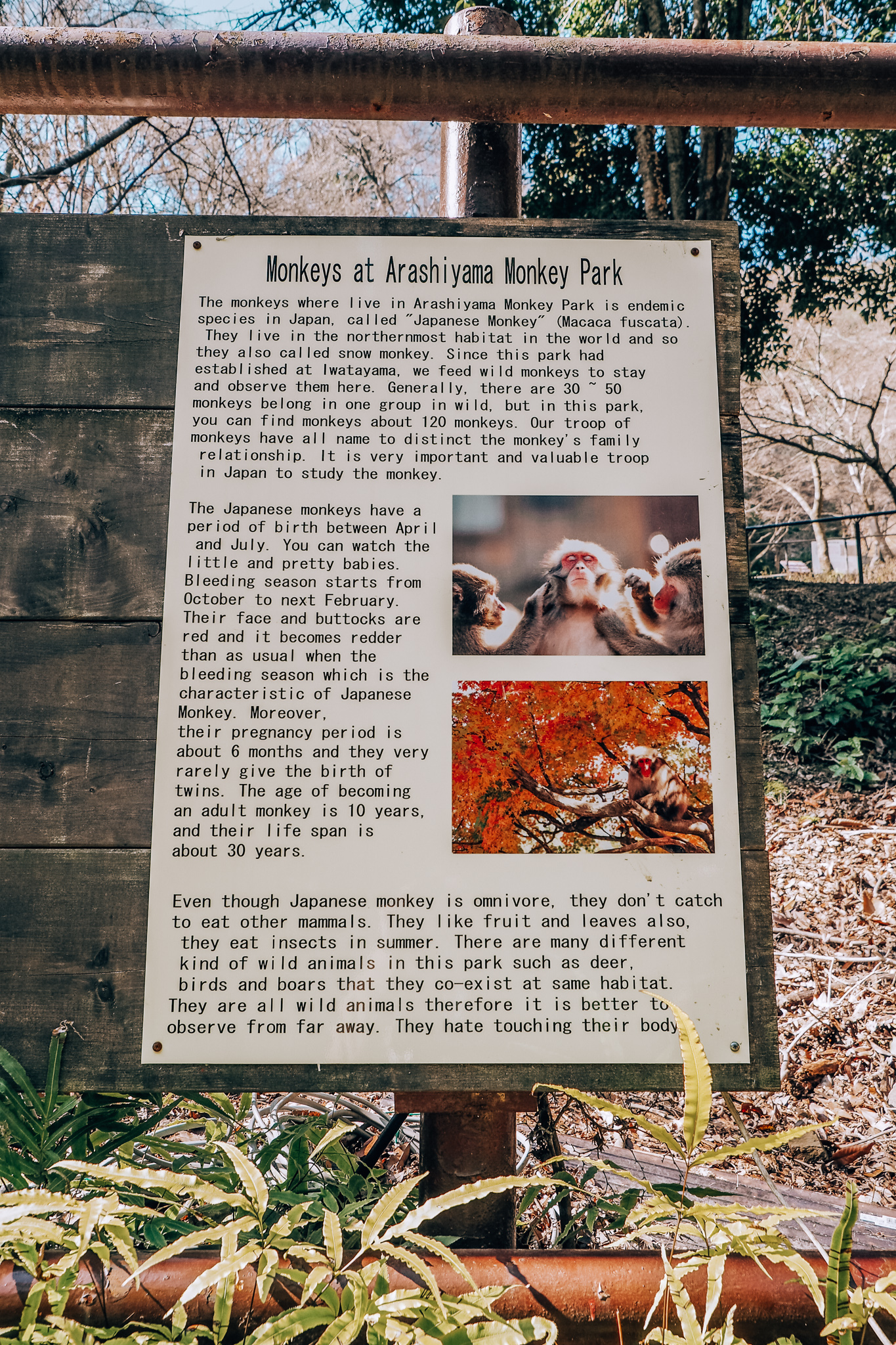
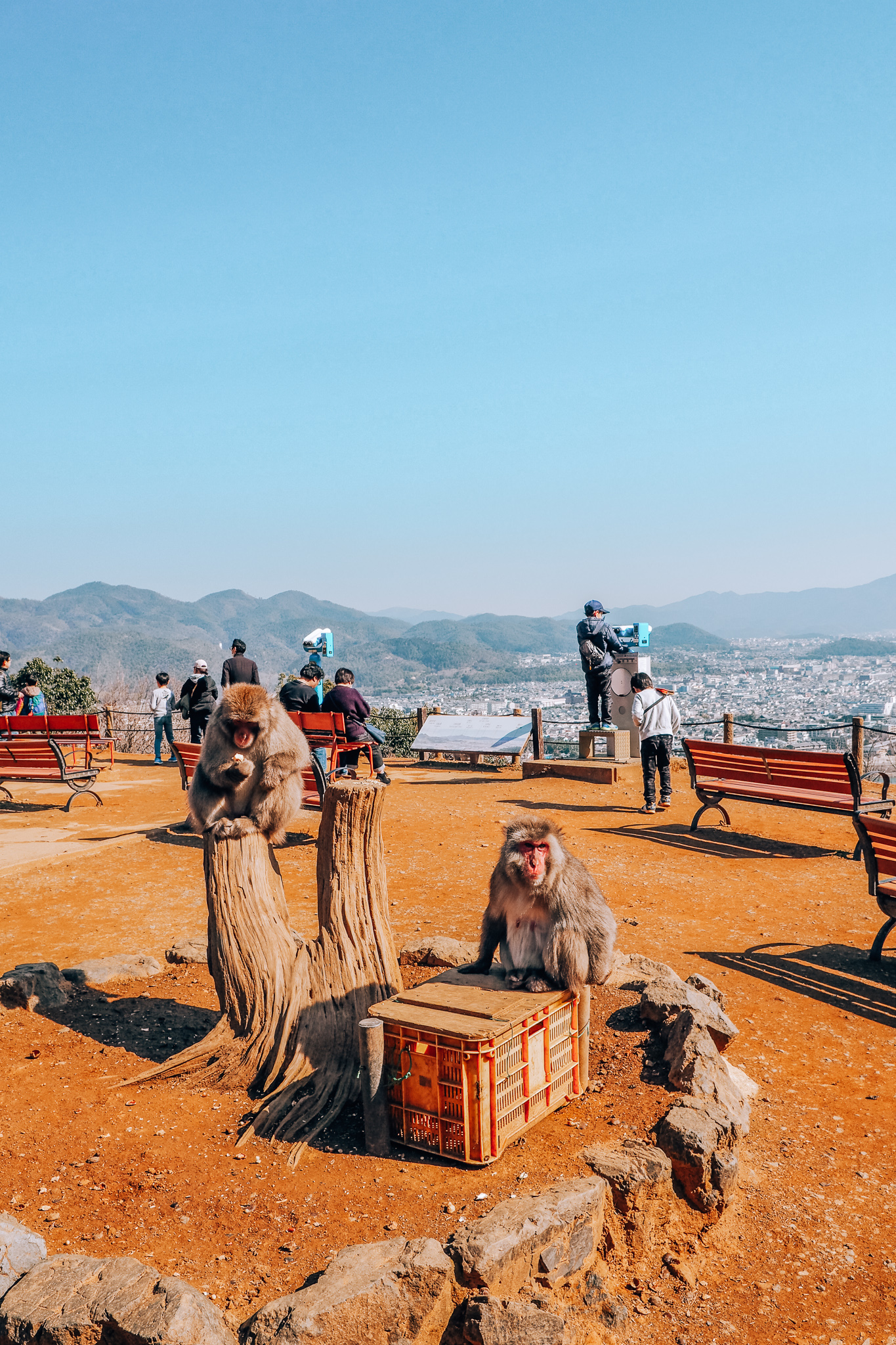
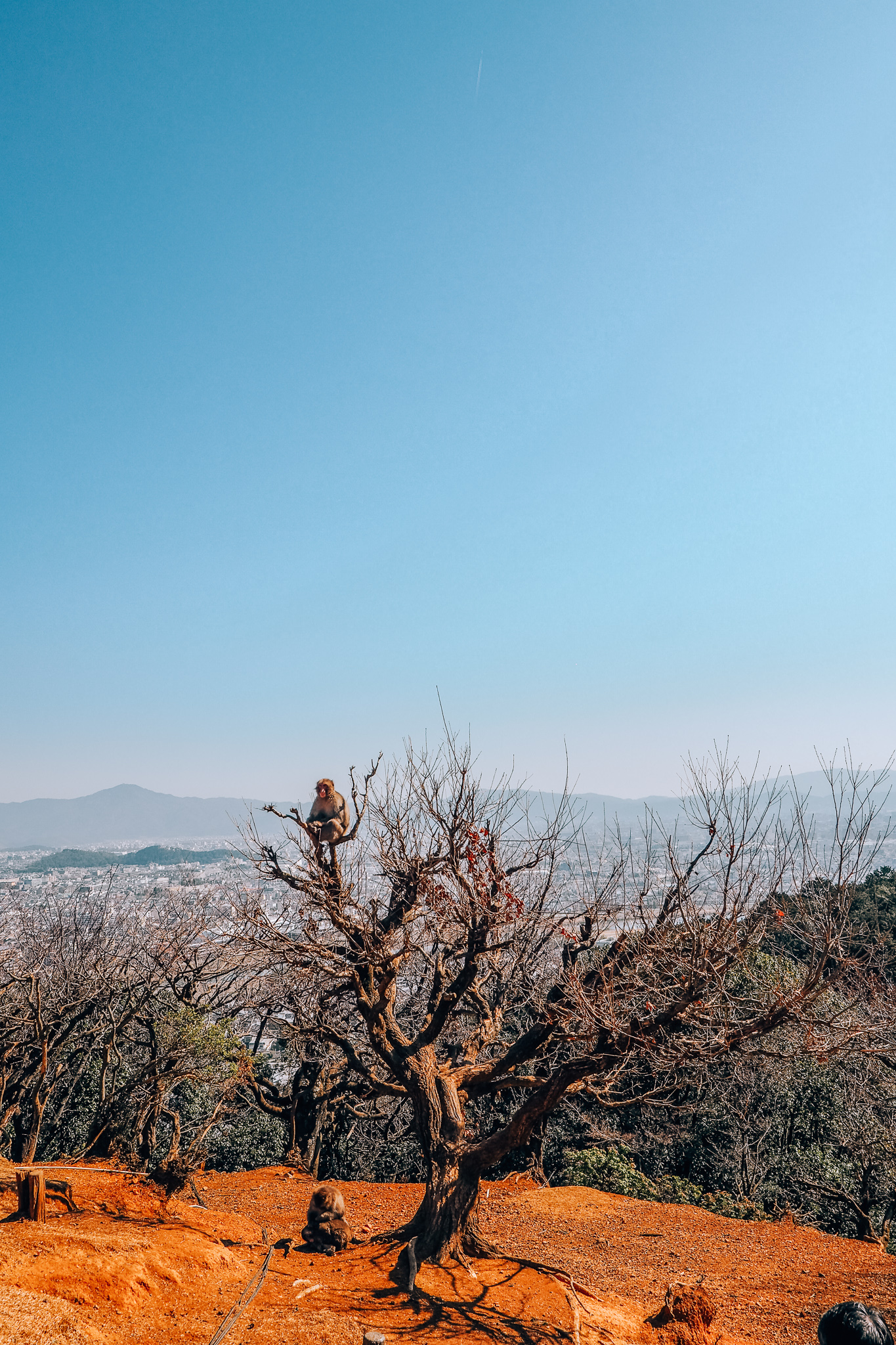

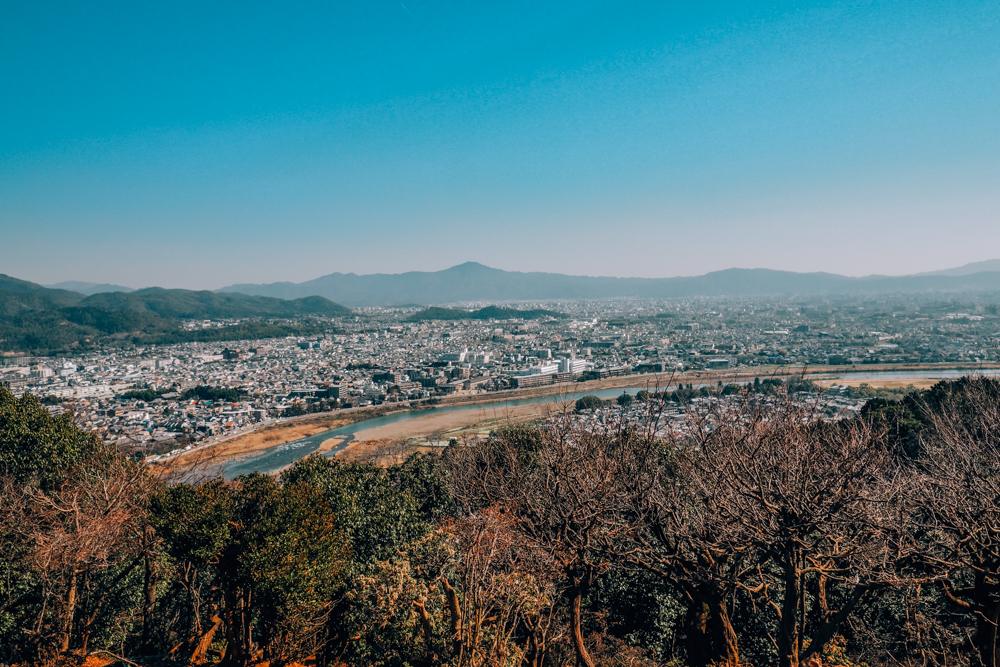
Tenryuji Temple
If you are enjoying your time visiting temples and learning more about them, then Tenryuji Temple is another one you might want to visit, both due to its proximity to the monkey park and because it is a UNESCO World Heritage site.
There are two types of admissions tickets – one for the garden which costs 500 yen and another to access the temple, which costs an additional 300 yen. Admittedly, we did neither and viewed it from the outside, but we did notice that Tenryuji’s World Heritage Gardens are home to a large temple-style vegetarian restaurant for those that are interested in having an early lunch here.
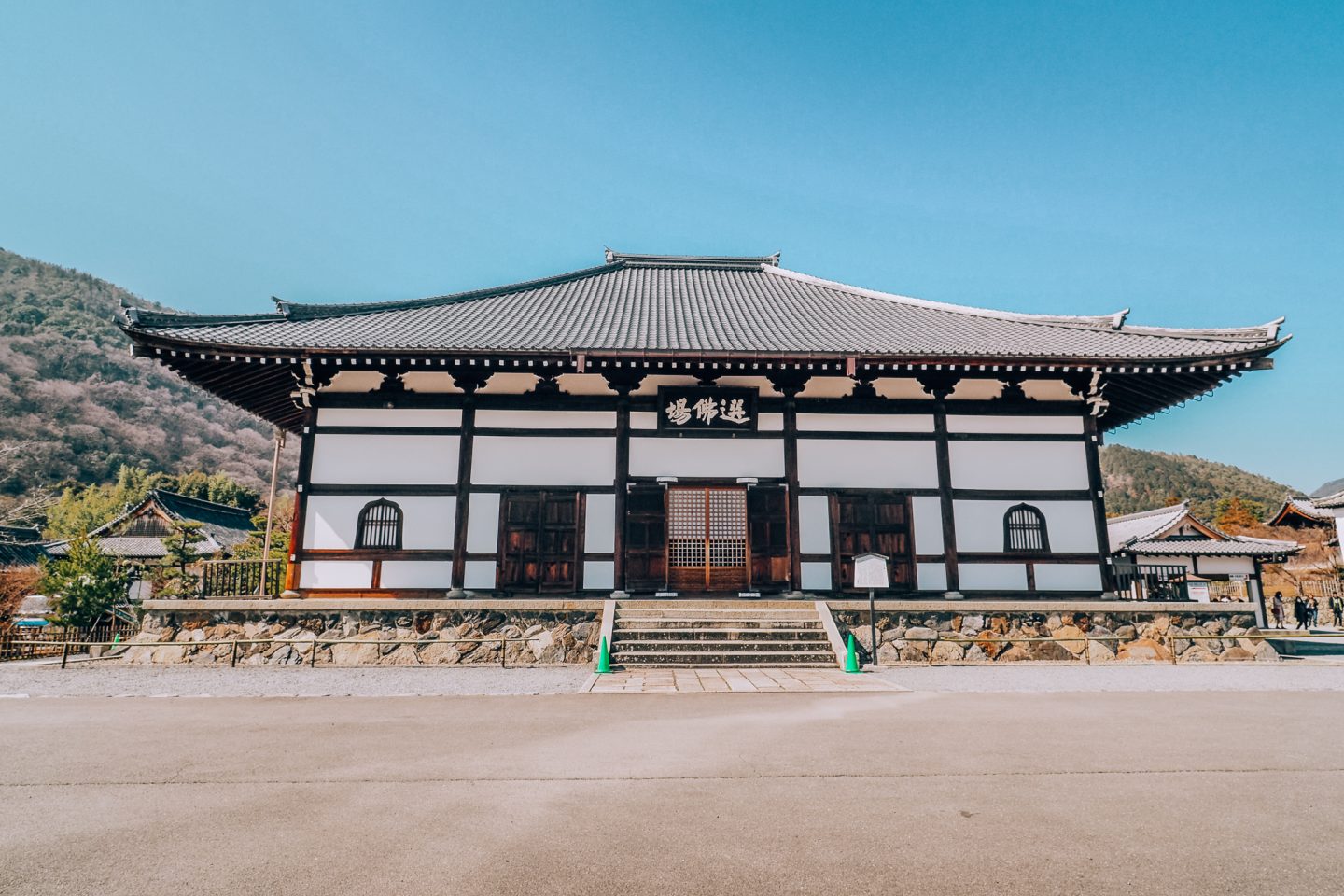
Arashiyama Bamboo Grove
Once you are ready from your time at the Tenryuji Temple, leave through the back entrance to find yourself at the Arashiyama Bamboo Forest. Only 30 minutes are needed here, but given how iconic the location is, it’s definitely one you can’t miss.
This is the final stop in Arashiyama, and from here it’s a 10 minute walk back to Saga-Arashiyama Station, before heading back to Kyoto Station via the San-In Line. If you haven’t had lunch yet, this is the station provides a great place to stop for those that want a bite to eat. We decided on a small restaurant called Tagoto, which served traditional soba noodle soup.
Once you’re ready from lunch or if you already picked up something to eat earlier in the day, it’s time to head to the next destination.
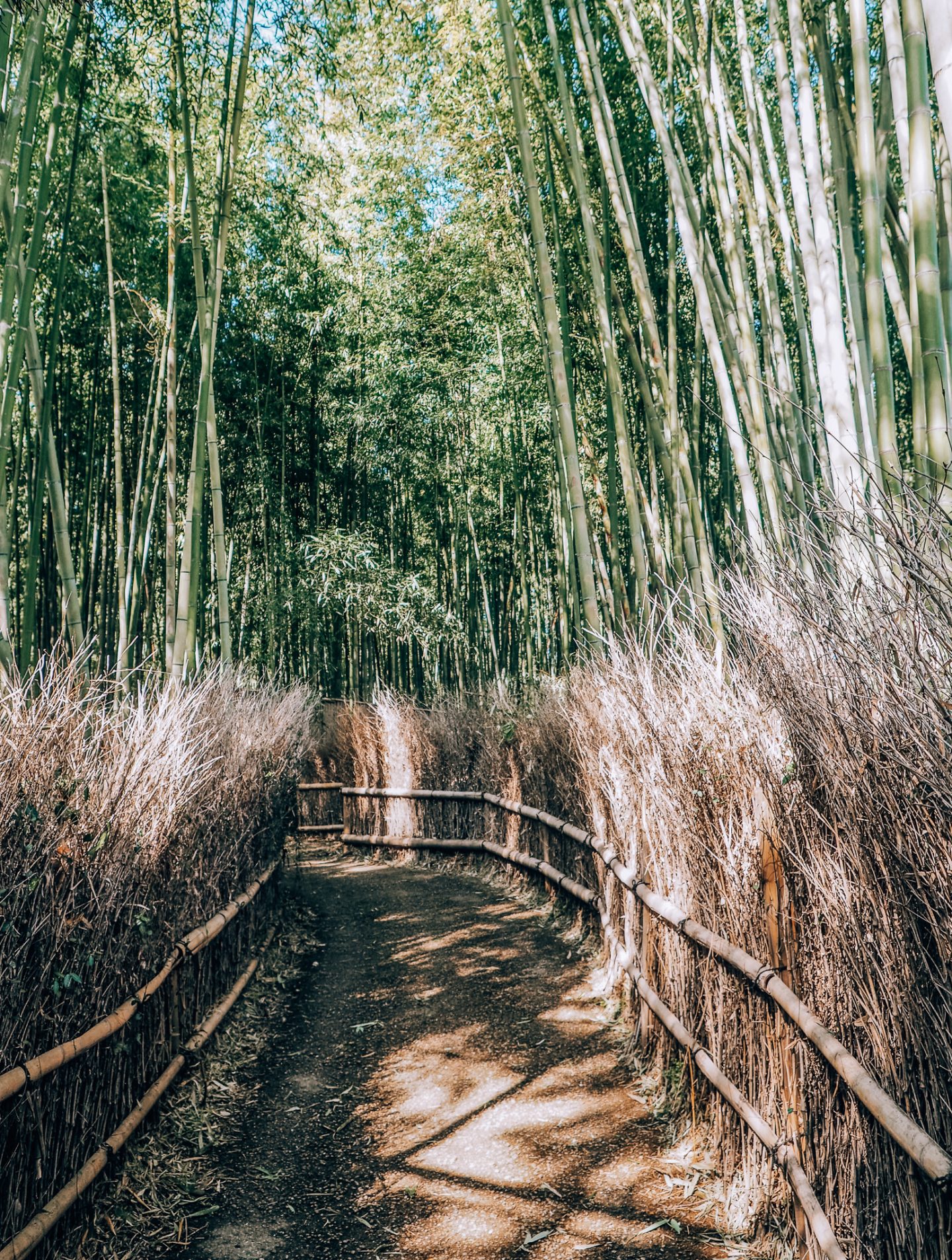
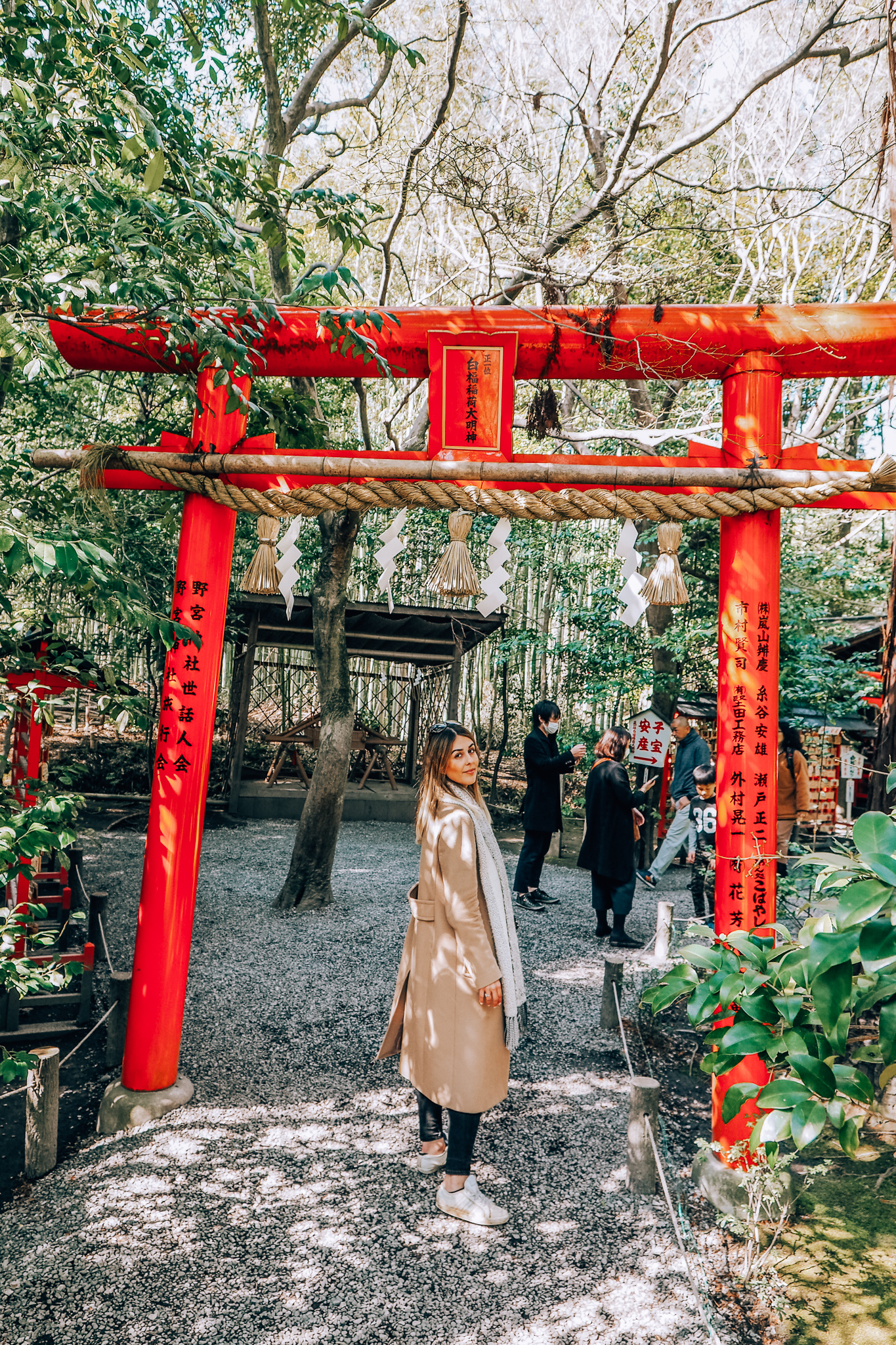
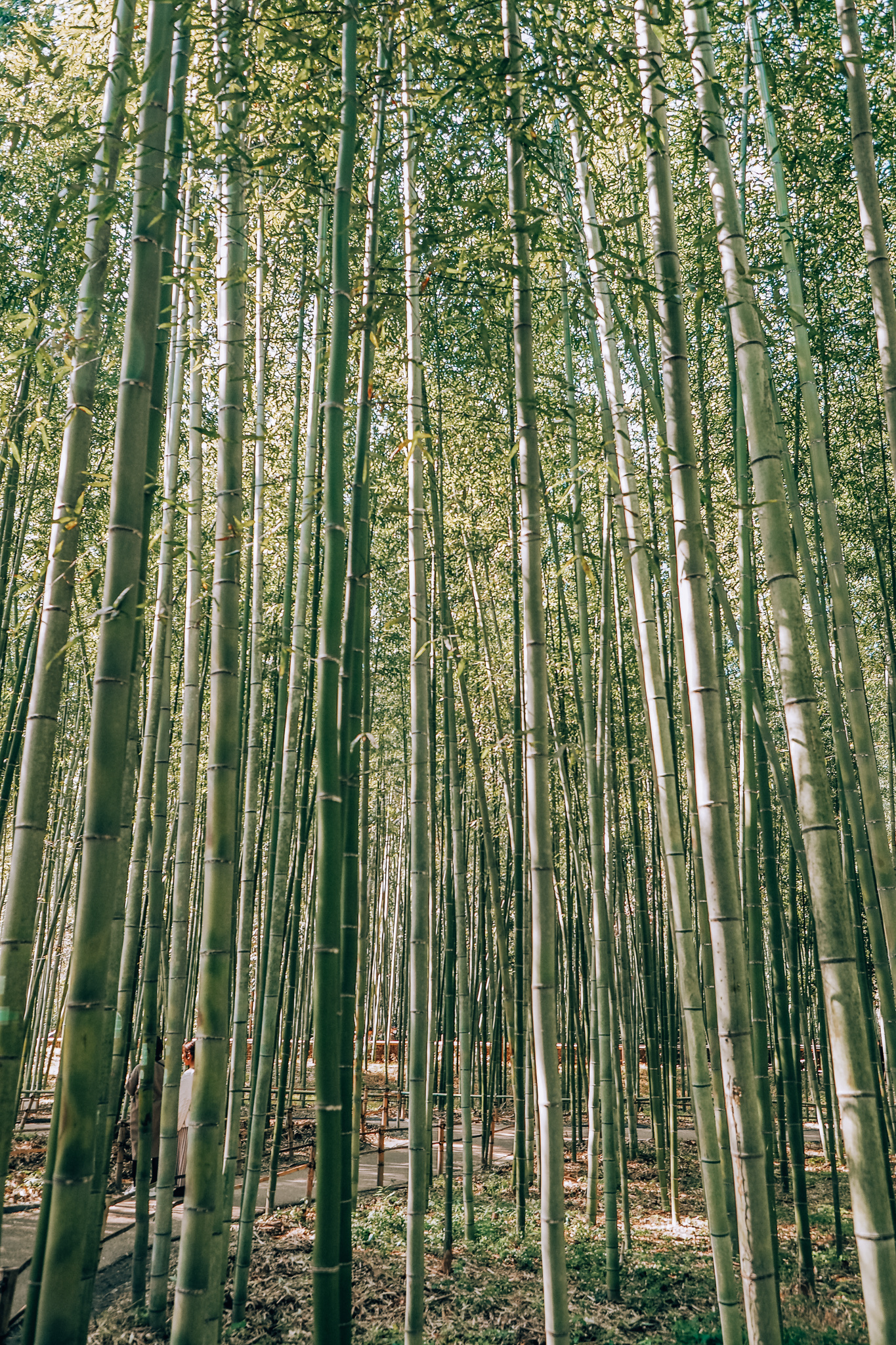
Fushimi Inari-taisha Shrine
The Fushimi Inari taisha Shrine is a short train ride from Kyoto Station to Inari Station on the JR Nara Line – again, you can use your JR Pass for the journey. Upon arriving, you will notice that it’s a big tourist hotspot.
The Fushimi Inari Shrine is one of the most iconic sites in Japan due to the thousands of bright vermilion torii gates throughout the trail leading up Mount Inari. You could spend hours hiking here and learning about the secrets of the shrine. The further up the mountain you go, the more the tourists start to dwindle. I felt incredibly overwhelmed at this shrine because there is so much to see and experience. In fact, if I was to do it again, I would recommend hiring a tour guide, who can talk you through the shrines and parts worth noting.
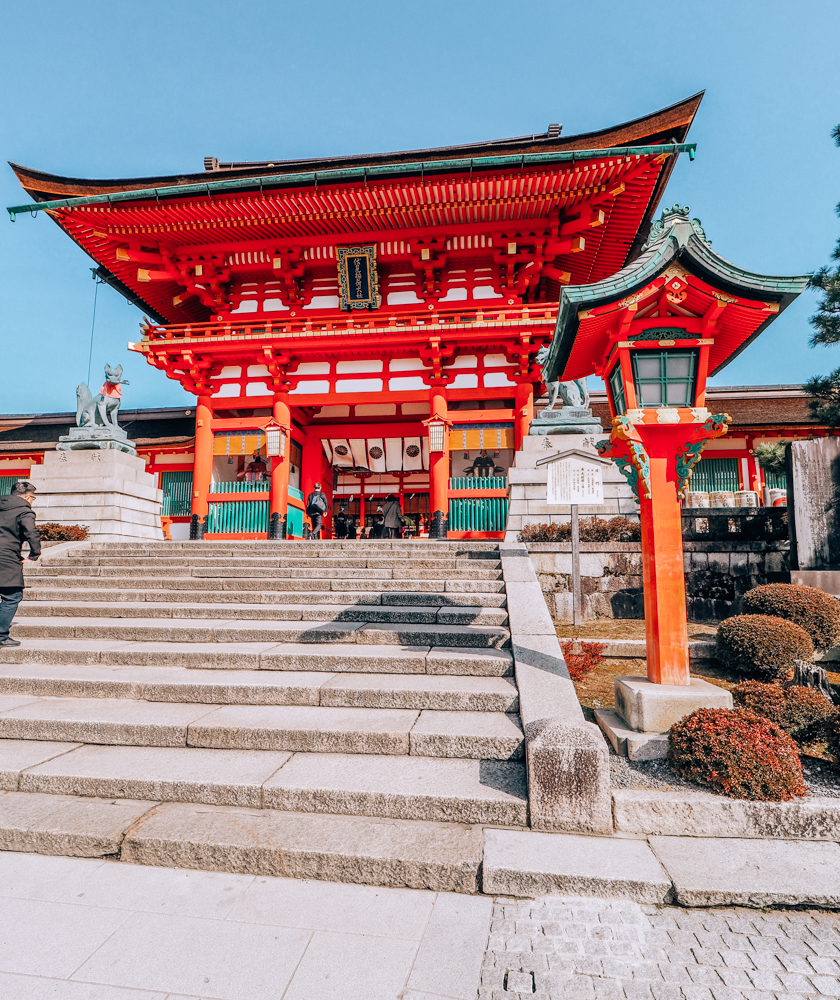
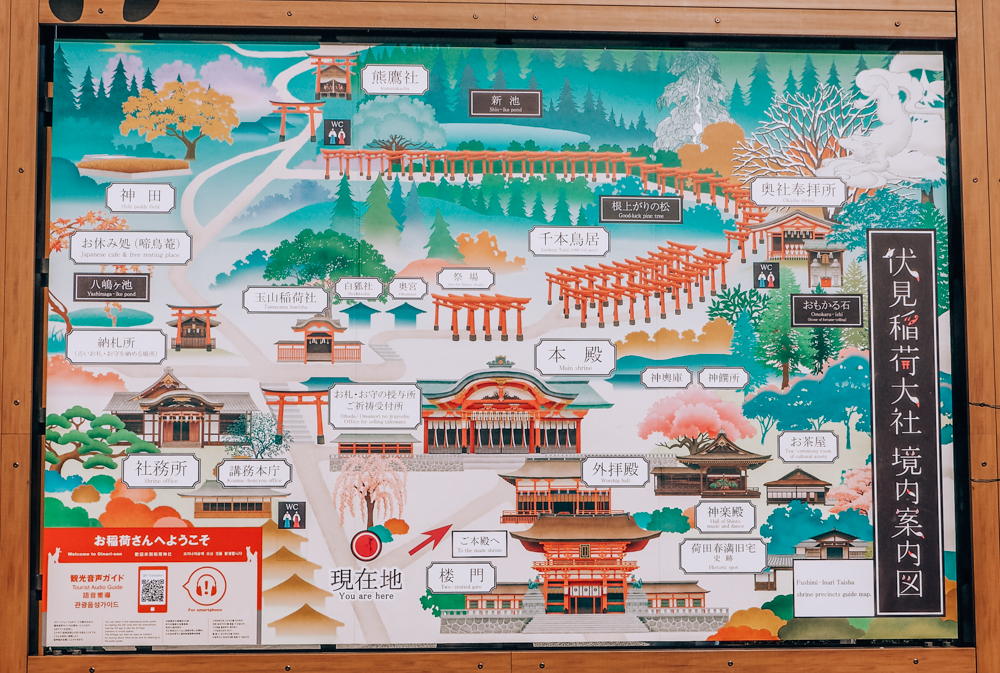
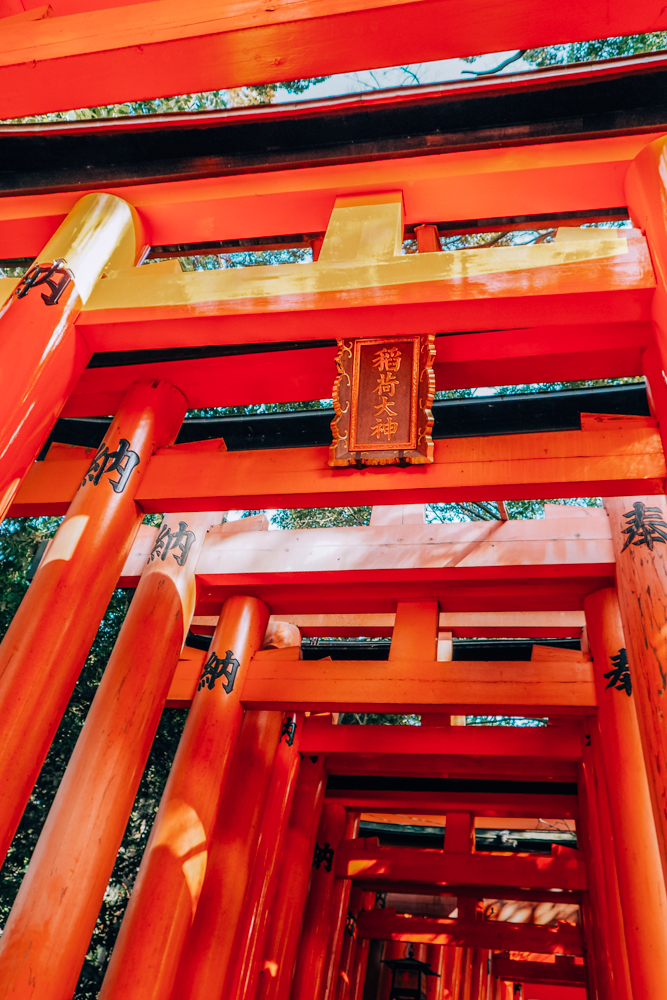
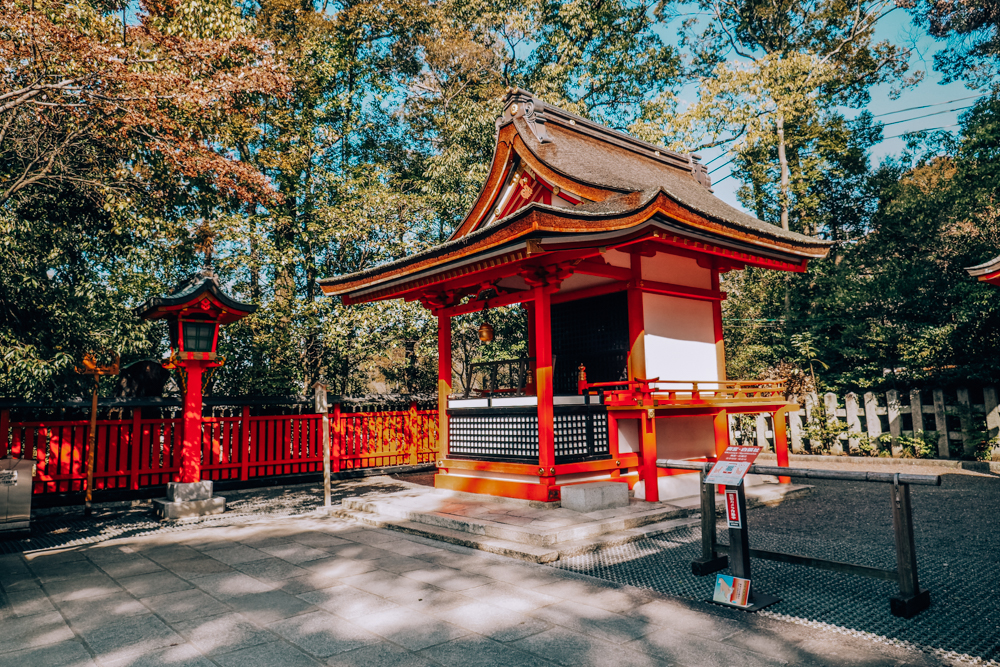
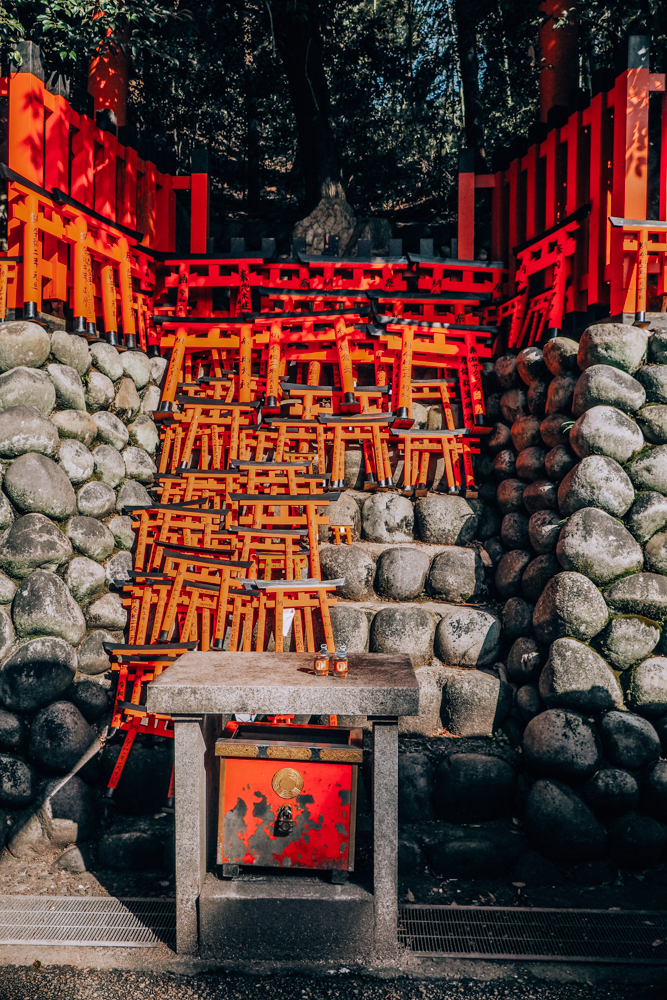
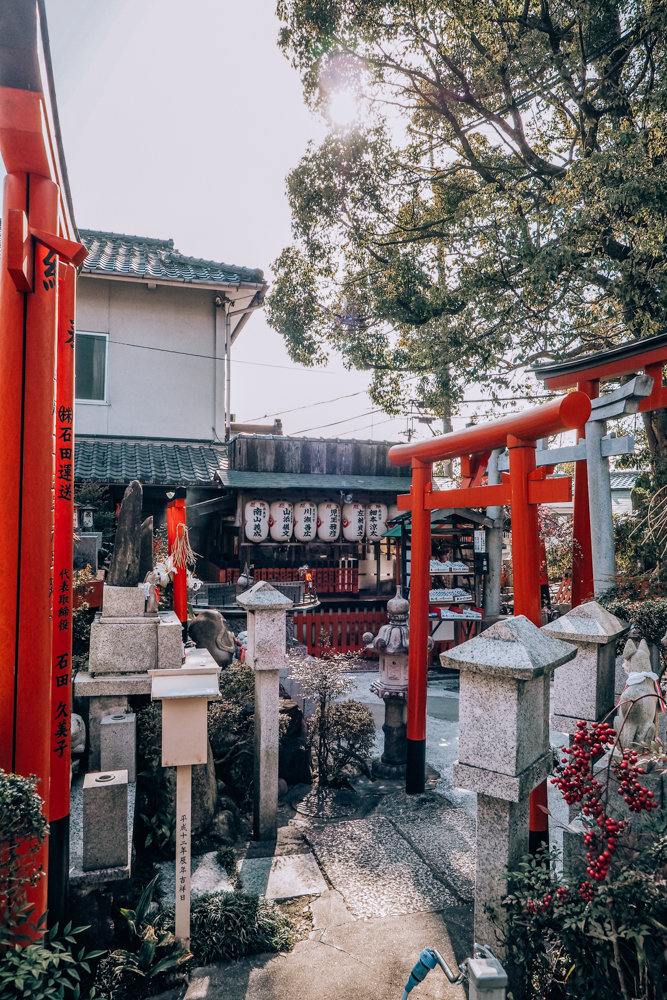
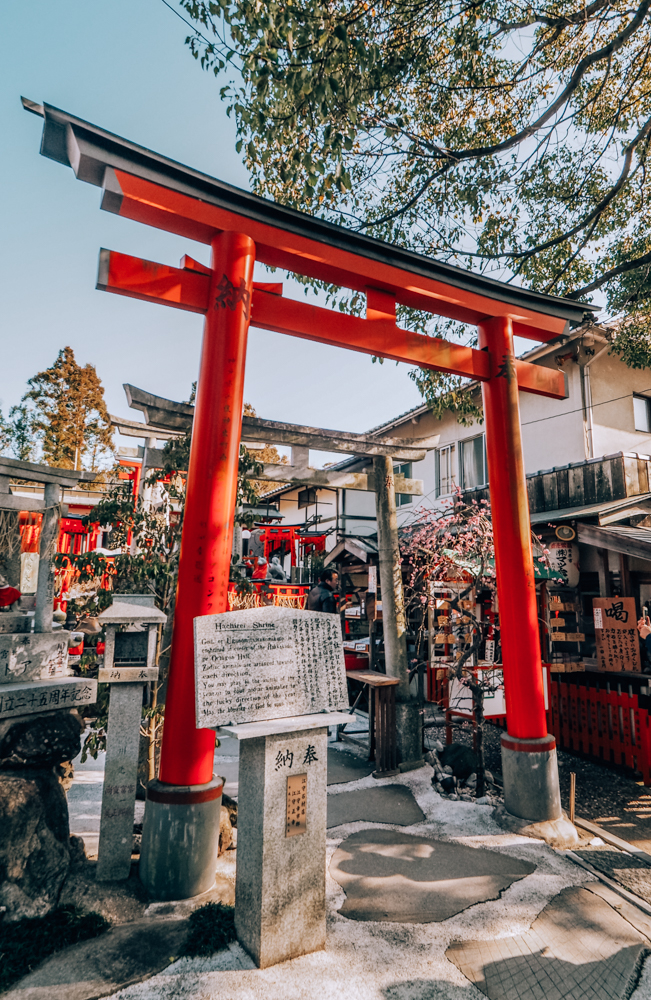
What I did learn when researching for this article is that this is one of thousands of shrines dedicated to Inari – the Shinto God of rice. Foxes are believed to be Inari’s messengers, and it is for this reason that you will see many fox statues scattered throughout.
Klook offers a group Fushimi Hidden Route Hiking Tour which lasts about 4 hours. I’ve linked it here, however you will need to make some adjustments to this itinerary to accommodate it. Alternatively, you could find a private guide might be better suited to your schedule. Of course a guide is definitely not compulsory, and you can very much enjoy the hike and the shrine unguided.
Once you’ve spent all the time you needed at the Fushimi Inari-taisha Shrine, it’s time to head back to Kyoto Station for the final leg of our 2 days in Kyoto.
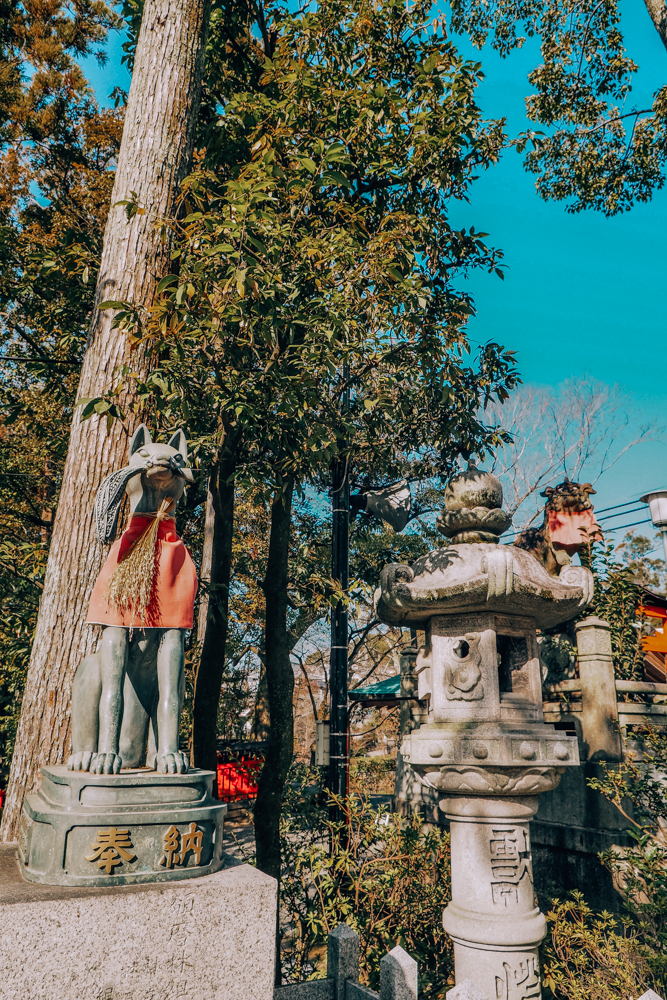


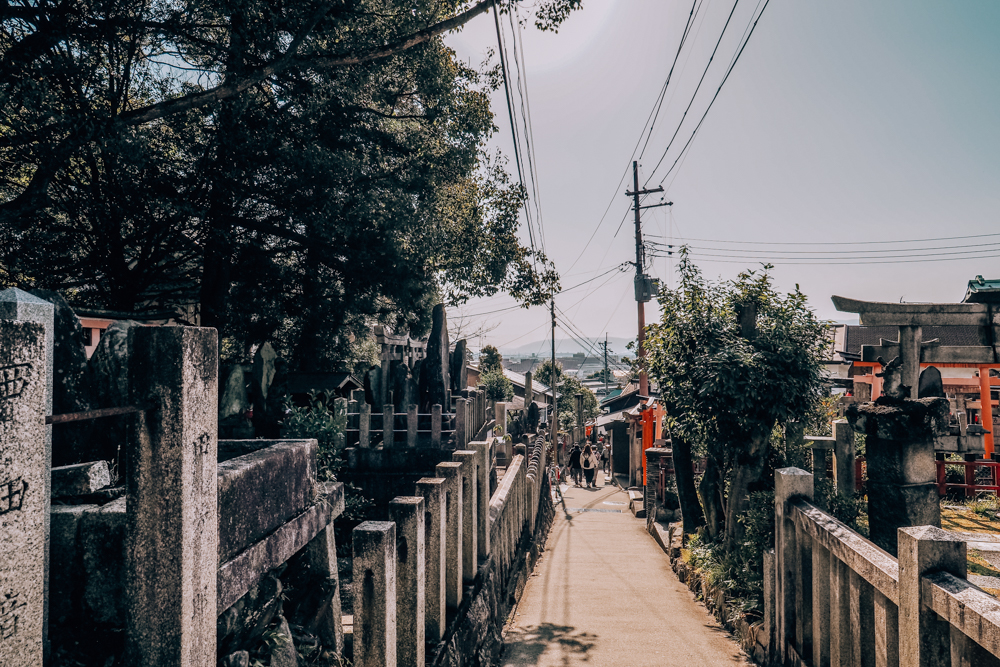
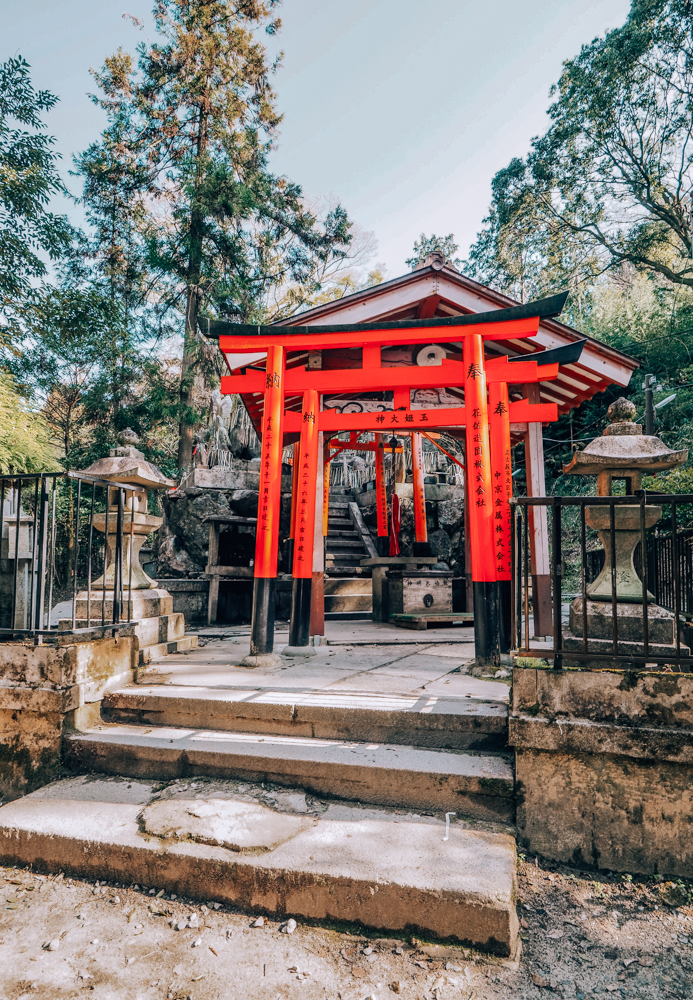
Kyoto Tower
I’m adding this to the itinerary given it is just by the station, but I did not visit myself. We had been to observation decks in Tokyo and Osaka, so decided to give this a miss. That being said, if you haven’t yet been to an observation deck yet, the views look beautiful. Here is a link where you can book tickets to the Kyoto Tower, where you can enjoy a panoramic view of the city of Kyoto from 100 meters up.

Avanti Department Store
To end this super packed Kyoto 2 day itinerary, and for those that still have some energy left in them, the Avanti Department Store is located just outside of Kyoto Station. It is the perfect place to stock up on Japanese goodies (we actually bought a tea whisk like what was used in the tea ceremony) as well as well-known Japanese brands that are much cheaper than if bought in Europe or the US.

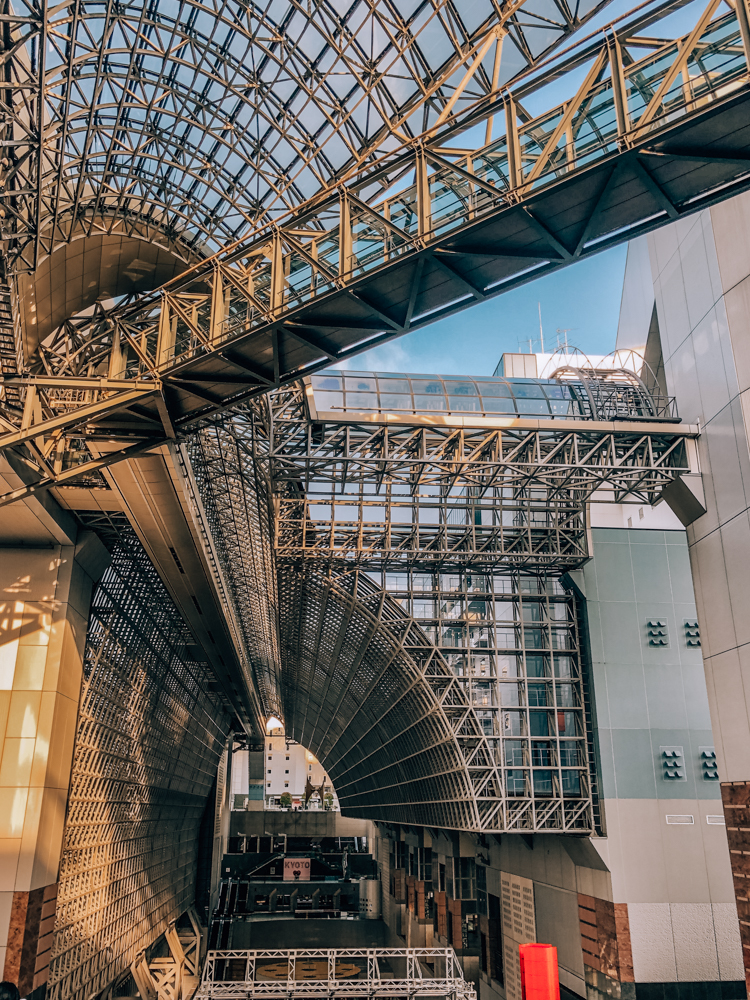
I am truly excited for anyone planning any Japan travel as it is such an incredible country. From the culture to the food, to its 23 world heritage sites, there is so much waiting to be enjoyed and experienced. I’ll slowly be publishing a series of travel guides on Tokyo, Osaka, Nara and Hakone so stay tuned for those!
I hope this article was helpful for anyone heading to Kyoto in the near future. If you have followed this itinerary for your upcoming trip, please do tag us in your images using @dukes_avenue on Instagram!
If you are fascinated by this incredible country and its culture, you might want to check out my article all about Japanese tea ceremony etiquette and how it can help us in everyday life.
For more of my travel guides and travel tips, visit the Travel section of this website.
Shop My Look (all similar items)
TRAVEL TO KYOTO

Don’t forget to pin this article if you found it helpful, and follow Dukes Avenue on Pinterest for more!
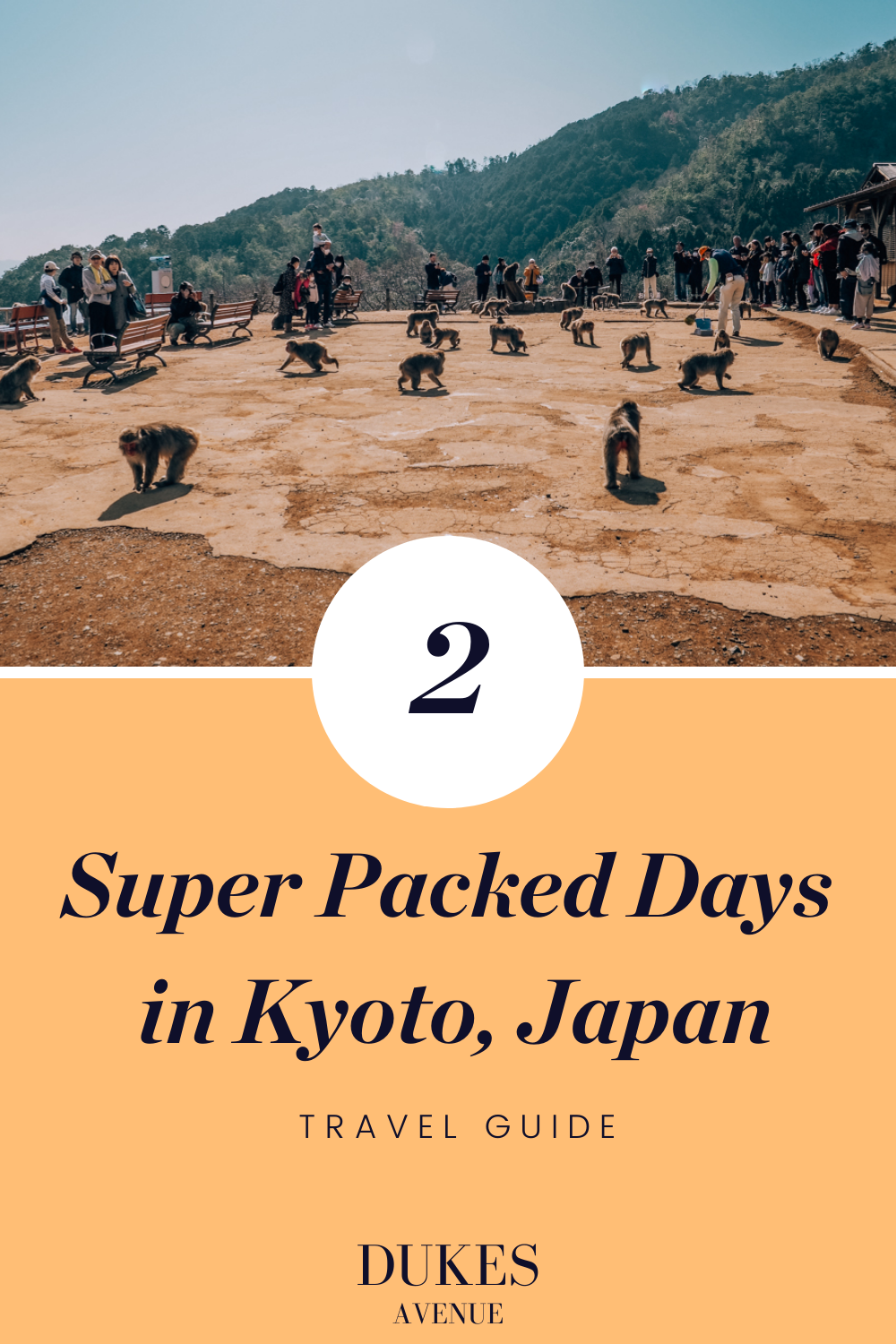
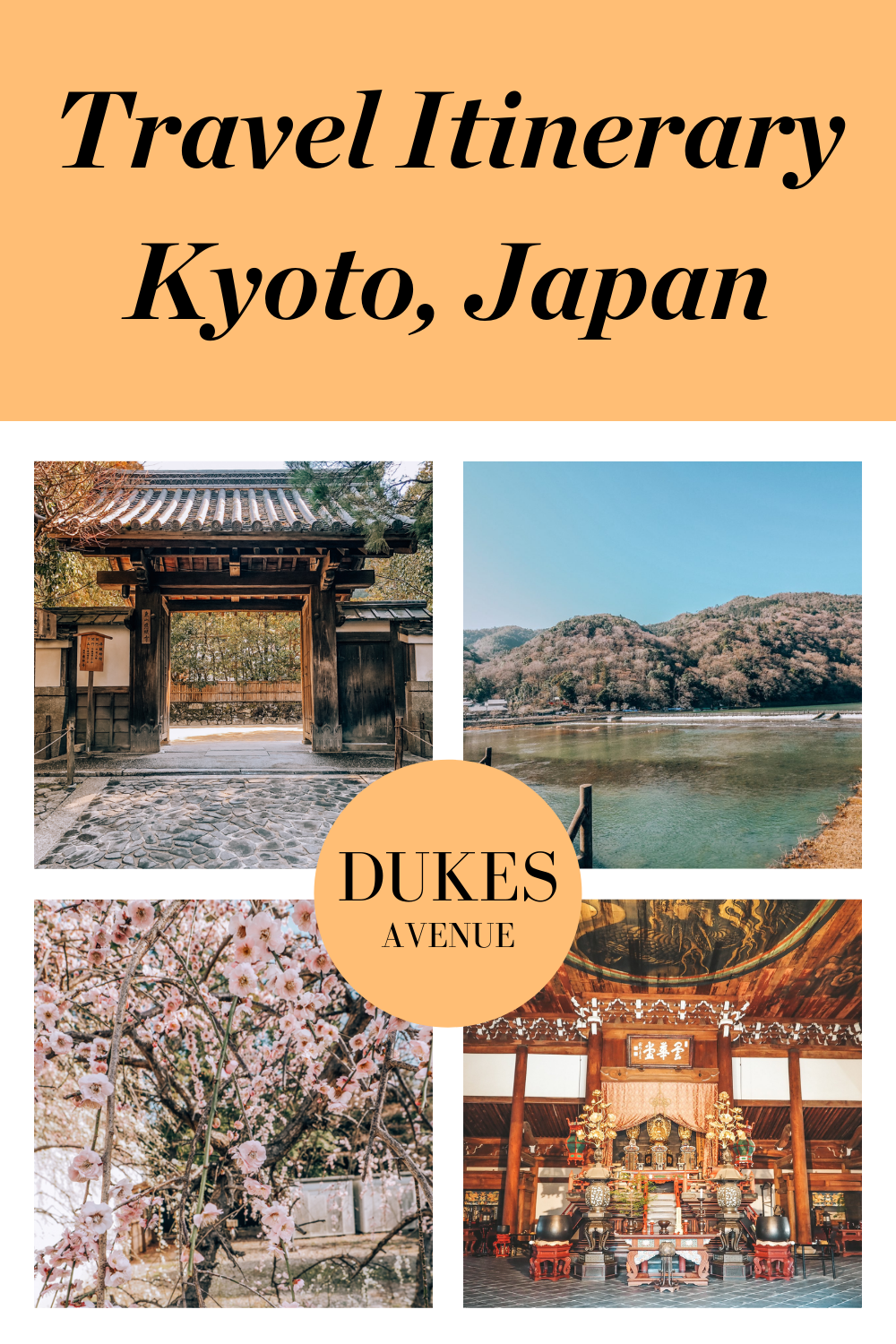
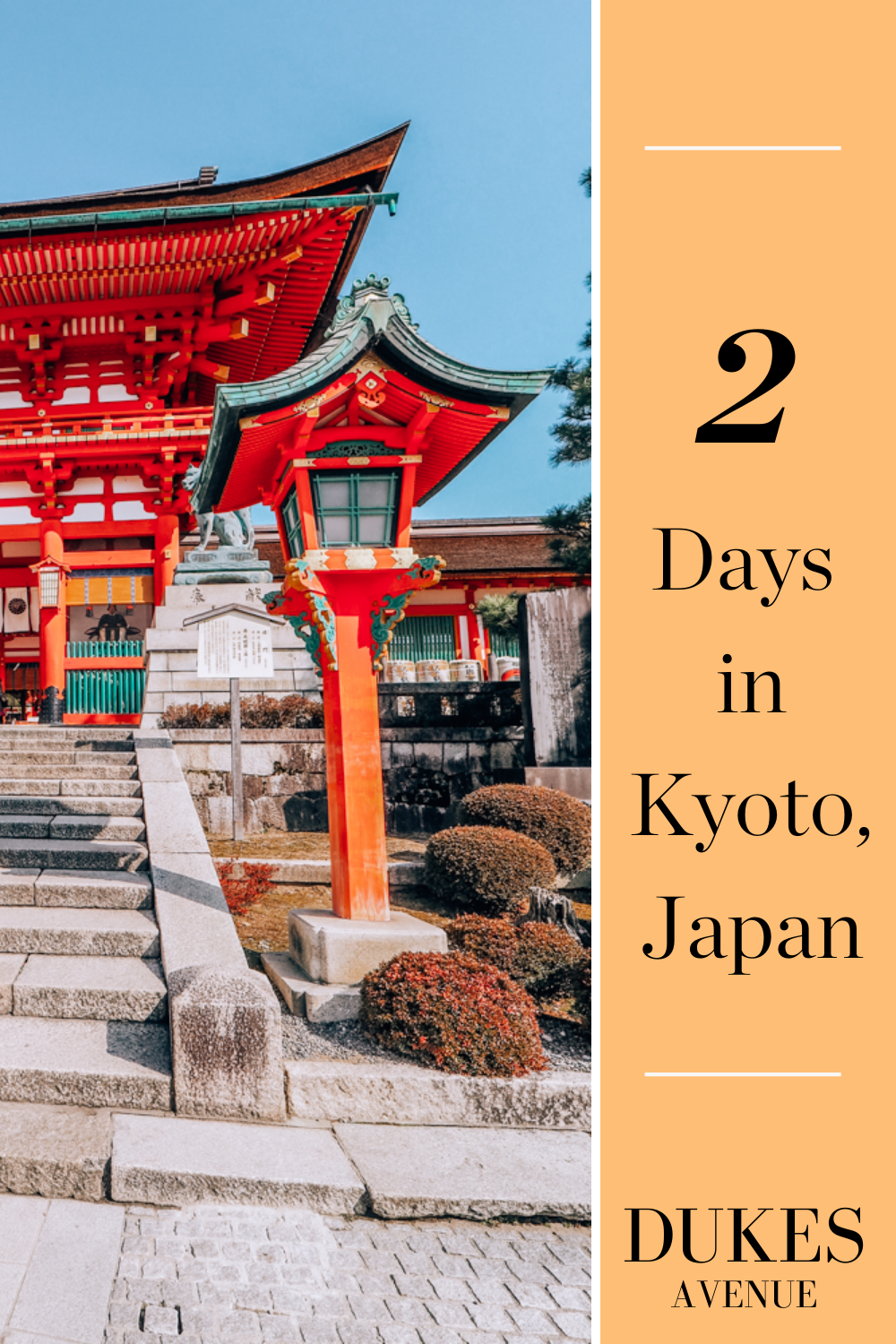

Sarah founded Dukes Avenue in 2018 as a creative outlet while working at a London hedge fund. What initially started as a small blog has become a widely read luxury lifestyle online publication targeted at the modern woman, with content curated to inspire readers to live their best and most fulfilled lives. Sarah has lived in London, Malta, and, most recently, the United Arab Emirates and uses her travels and experiences to inspire much of the content.
